Enterprise Architecture (EA)
VerifiedAdded on 2023/06/04
|22
|5074
|51
AI Summary
This article discusses Enterprise Architecture (EA) and its importance in aligning IT with business, efficient IT operations, better return on investment, and more. It covers the elements and six-element of EA, documentation, and its effectiveness in implementation. It also talks about the values of establishing EA program in an enterprise, the risks associated with it, and ways to manage change with stakeholders. The article is relevant to Business management, IT management, and IT governance. The subject and course code are not mentioned.
Contribute Materials
Your contribution can guide someone’s learning journey. Share your
documents today.
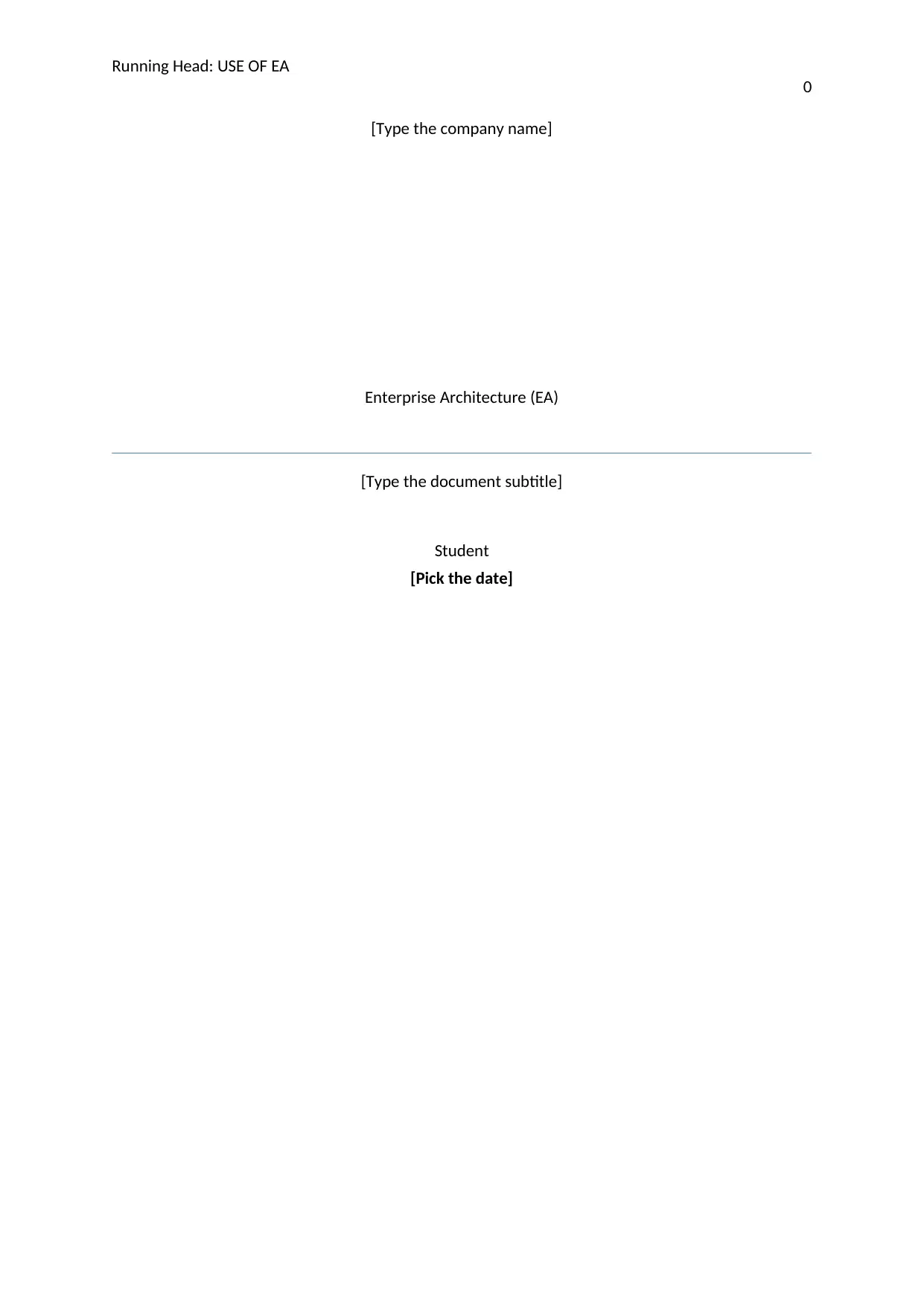
Running Head: USE OF EA
0
[Type the company name]
Enterprise Architecture (EA)
[Type the document subtitle]
Student
[Pick the date]
0
[Type the company name]
Enterprise Architecture (EA)
[Type the document subtitle]
Student
[Pick the date]
Secure Best Marks with AI Grader
Need help grading? Try our AI Grader for instant feedback on your assignments.
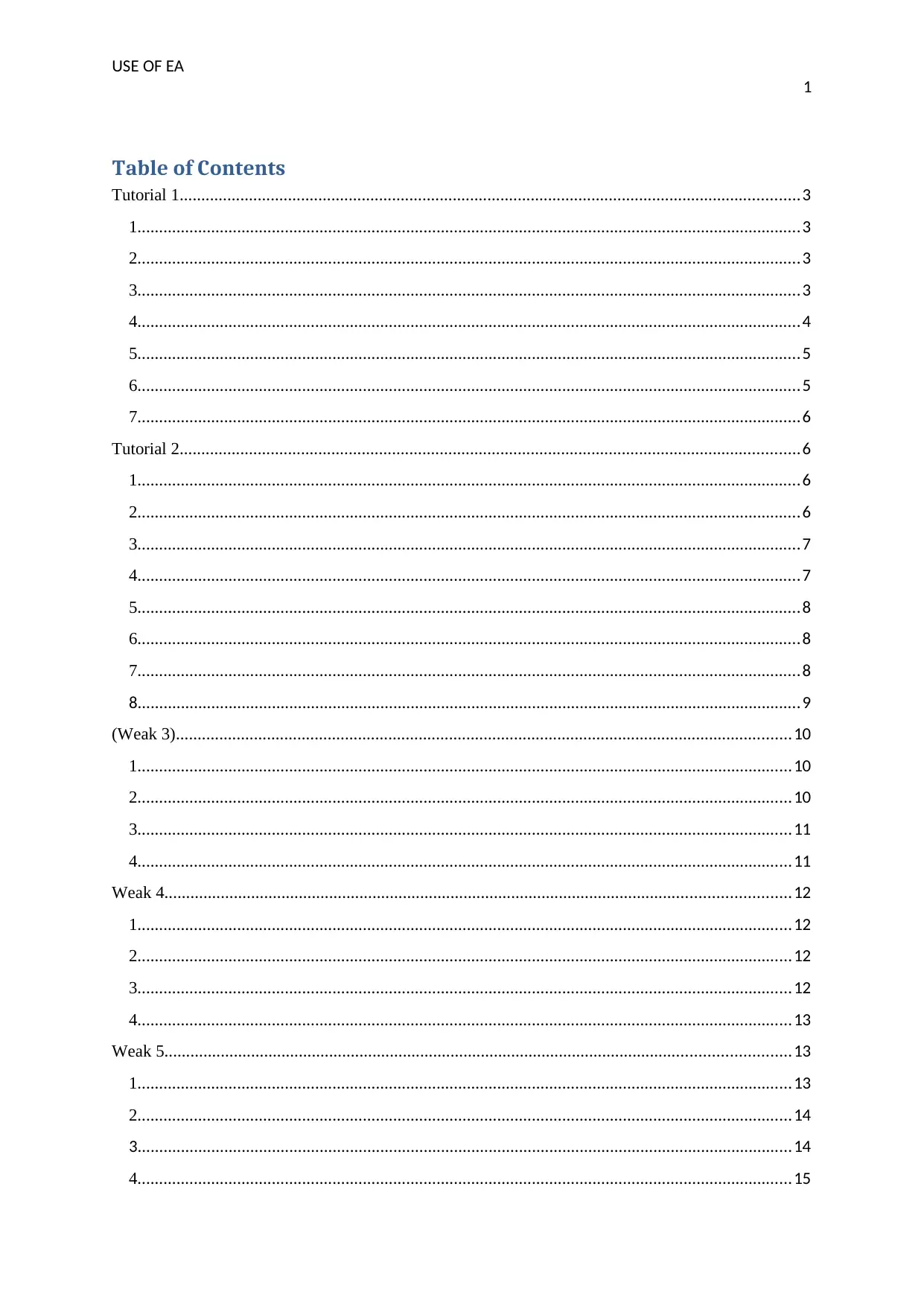
USE OF EA
1
Table of Contents
Tutorial 1...............................................................................................................................................3
1.........................................................................................................................................................3
2.........................................................................................................................................................3
3.........................................................................................................................................................3
4.........................................................................................................................................................4
5.........................................................................................................................................................5
6.........................................................................................................................................................5
7.........................................................................................................................................................6
Tutorial 2...............................................................................................................................................6
1.........................................................................................................................................................6
2.........................................................................................................................................................6
3.........................................................................................................................................................7
4.........................................................................................................................................................7
5.........................................................................................................................................................8
6.........................................................................................................................................................8
7.........................................................................................................................................................8
8.........................................................................................................................................................9
(Weak 3)..............................................................................................................................................10
1.......................................................................................................................................................10
2.......................................................................................................................................................10
3.......................................................................................................................................................11
4.......................................................................................................................................................11
Weak 4................................................................................................................................................12
1.......................................................................................................................................................12
2.......................................................................................................................................................12
3.......................................................................................................................................................12
4.......................................................................................................................................................13
Weak 5................................................................................................................................................13
1.......................................................................................................................................................13
2.......................................................................................................................................................14
3.......................................................................................................................................................14
4.......................................................................................................................................................15
1
Table of Contents
Tutorial 1...............................................................................................................................................3
1.........................................................................................................................................................3
2.........................................................................................................................................................3
3.........................................................................................................................................................3
4.........................................................................................................................................................4
5.........................................................................................................................................................5
6.........................................................................................................................................................5
7.........................................................................................................................................................6
Tutorial 2...............................................................................................................................................6
1.........................................................................................................................................................6
2.........................................................................................................................................................6
3.........................................................................................................................................................7
4.........................................................................................................................................................7
5.........................................................................................................................................................8
6.........................................................................................................................................................8
7.........................................................................................................................................................8
8.........................................................................................................................................................9
(Weak 3)..............................................................................................................................................10
1.......................................................................................................................................................10
2.......................................................................................................................................................10
3.......................................................................................................................................................11
4.......................................................................................................................................................11
Weak 4................................................................................................................................................12
1.......................................................................................................................................................12
2.......................................................................................................................................................12
3.......................................................................................................................................................12
4.......................................................................................................................................................13
Weak 5................................................................................................................................................13
1.......................................................................................................................................................13
2.......................................................................................................................................................14
3.......................................................................................................................................................14
4.......................................................................................................................................................15
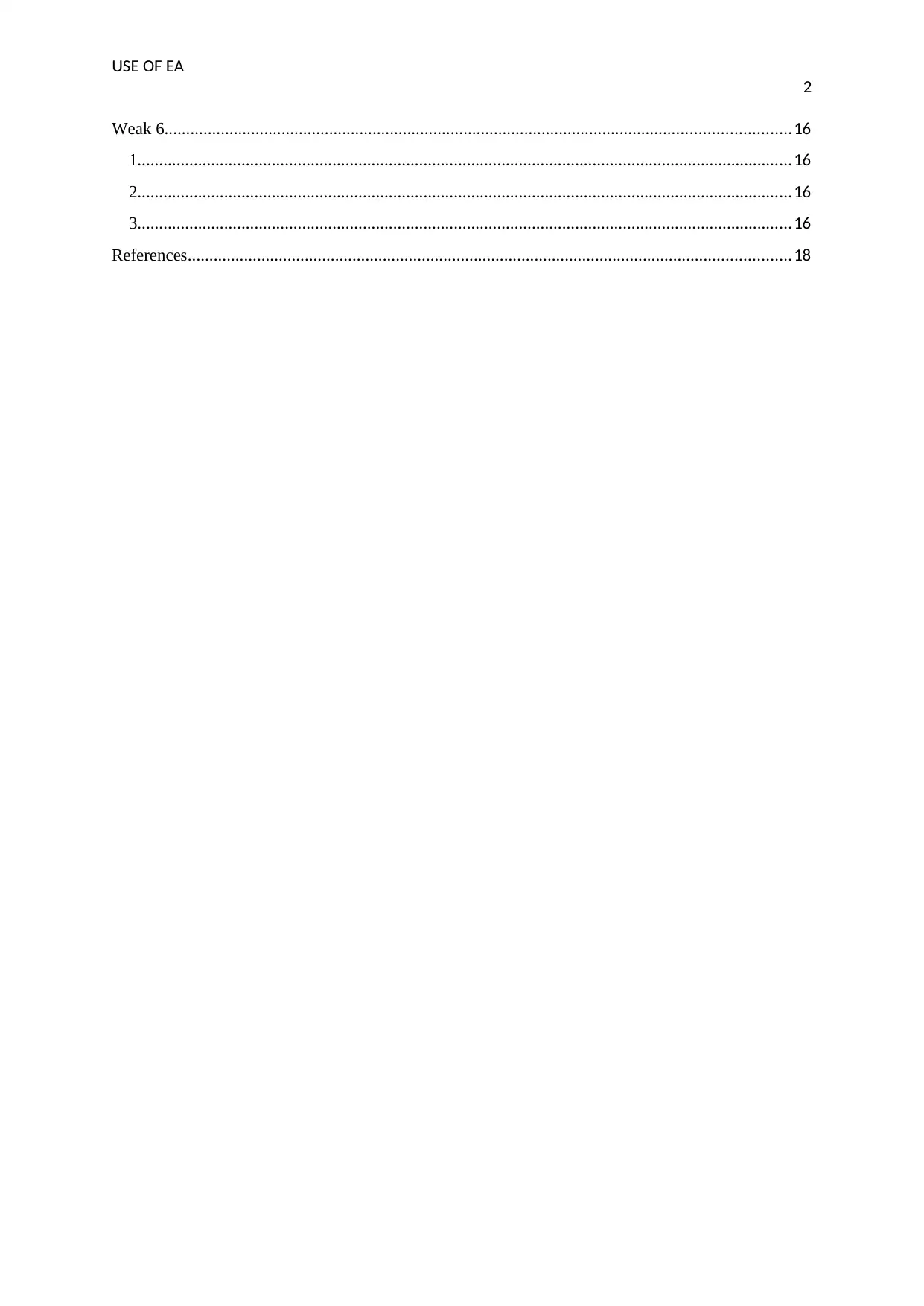
USE OF EA
2
Weak 6................................................................................................................................................16
1.......................................................................................................................................................16
2.......................................................................................................................................................16
3.......................................................................................................................................................16
References...........................................................................................................................................18
2
Weak 6................................................................................................................................................16
1.......................................................................................................................................................16
2.......................................................................................................................................................16
3.......................................................................................................................................................16
References...........................................................................................................................................18
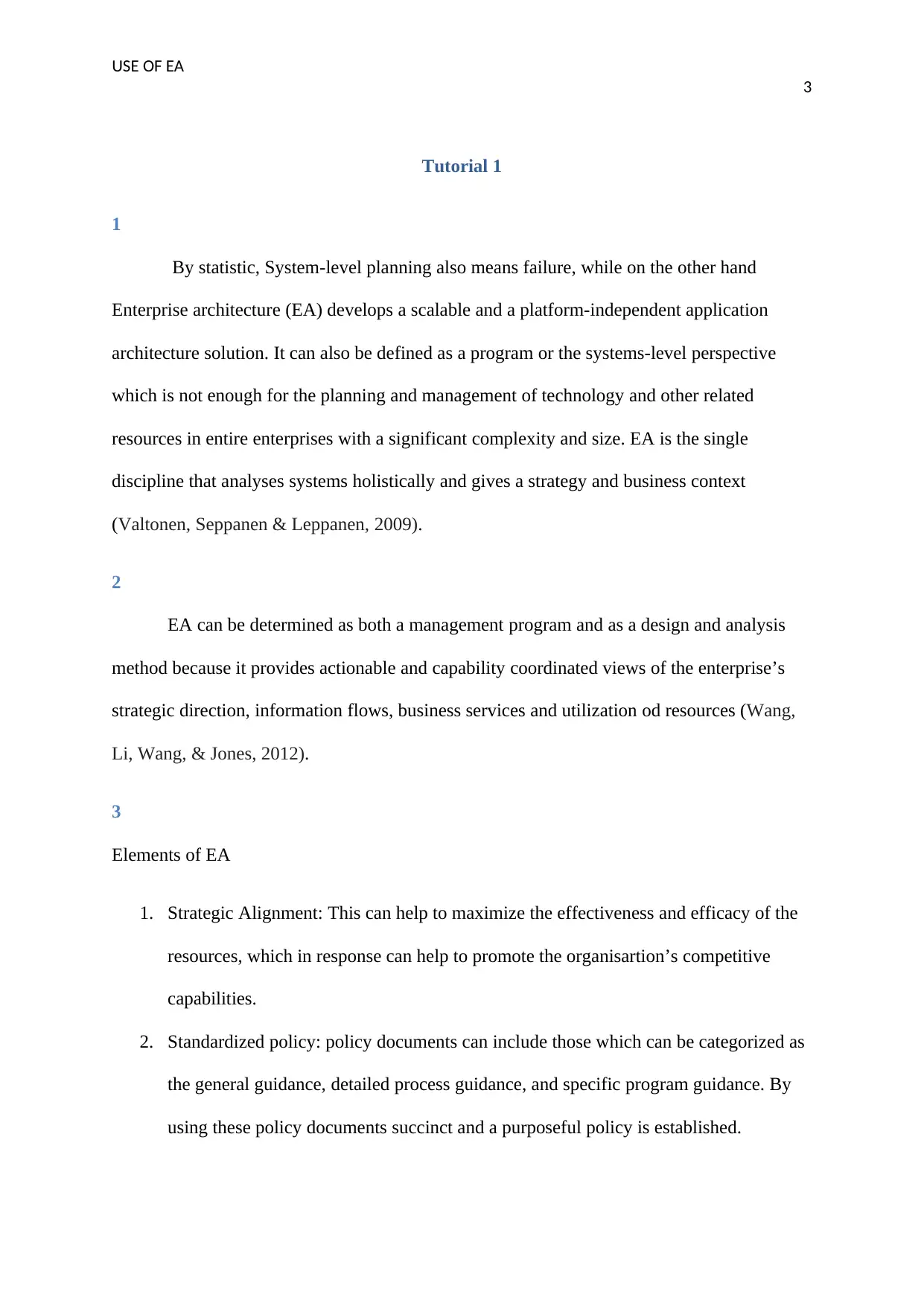
USE OF EA
3
Tutorial 1
1
By statistic, System-level planning also means failure, while on the other hand
Enterprise architecture (EA) develops a scalable and a platform-independent application
architecture solution. It can also be defined as a program or the systems-level perspective
which is not enough for the planning and management of technology and other related
resources in entire enterprises with a significant complexity and size. EA is the single
discipline that analyses systems holistically and gives a strategy and business context
(Valtonen, Seppanen & Leppanen, 2009).
2
EA can be determined as both a management program and as a design and analysis
method because it provides actionable and capability coordinated views of the enterprise’s
strategic direction, information flows, business services and utilization od resources (Wang,
Li, Wang, & Jones, 2012).
3
Elements of EA
1. Strategic Alignment: This can help to maximize the effectiveness and efficacy of the
resources, which in response can help to promote the organisartion’s competitive
capabilities.
2. Standardized policy: policy documents can include those which can be categorized as
the general guidance, detailed process guidance, and specific program guidance. By
using these policy documents succinct and a purposeful policy is established.
3
Tutorial 1
1
By statistic, System-level planning also means failure, while on the other hand
Enterprise architecture (EA) develops a scalable and a platform-independent application
architecture solution. It can also be defined as a program or the systems-level perspective
which is not enough for the planning and management of technology and other related
resources in entire enterprises with a significant complexity and size. EA is the single
discipline that analyses systems holistically and gives a strategy and business context
(Valtonen, Seppanen & Leppanen, 2009).
2
EA can be determined as both a management program and as a design and analysis
method because it provides actionable and capability coordinated views of the enterprise’s
strategic direction, information flows, business services and utilization od resources (Wang,
Li, Wang, & Jones, 2012).
3
Elements of EA
1. Strategic Alignment: This can help to maximize the effectiveness and efficacy of the
resources, which in response can help to promote the organisartion’s competitive
capabilities.
2. Standardized policy: policy documents can include those which can be categorized as
the general guidance, detailed process guidance, and specific program guidance. By
using these policy documents succinct and a purposeful policy is established.
Secure Best Marks with AI Grader
Need help grading? Try our AI Grader for instant feedback on your assignments.
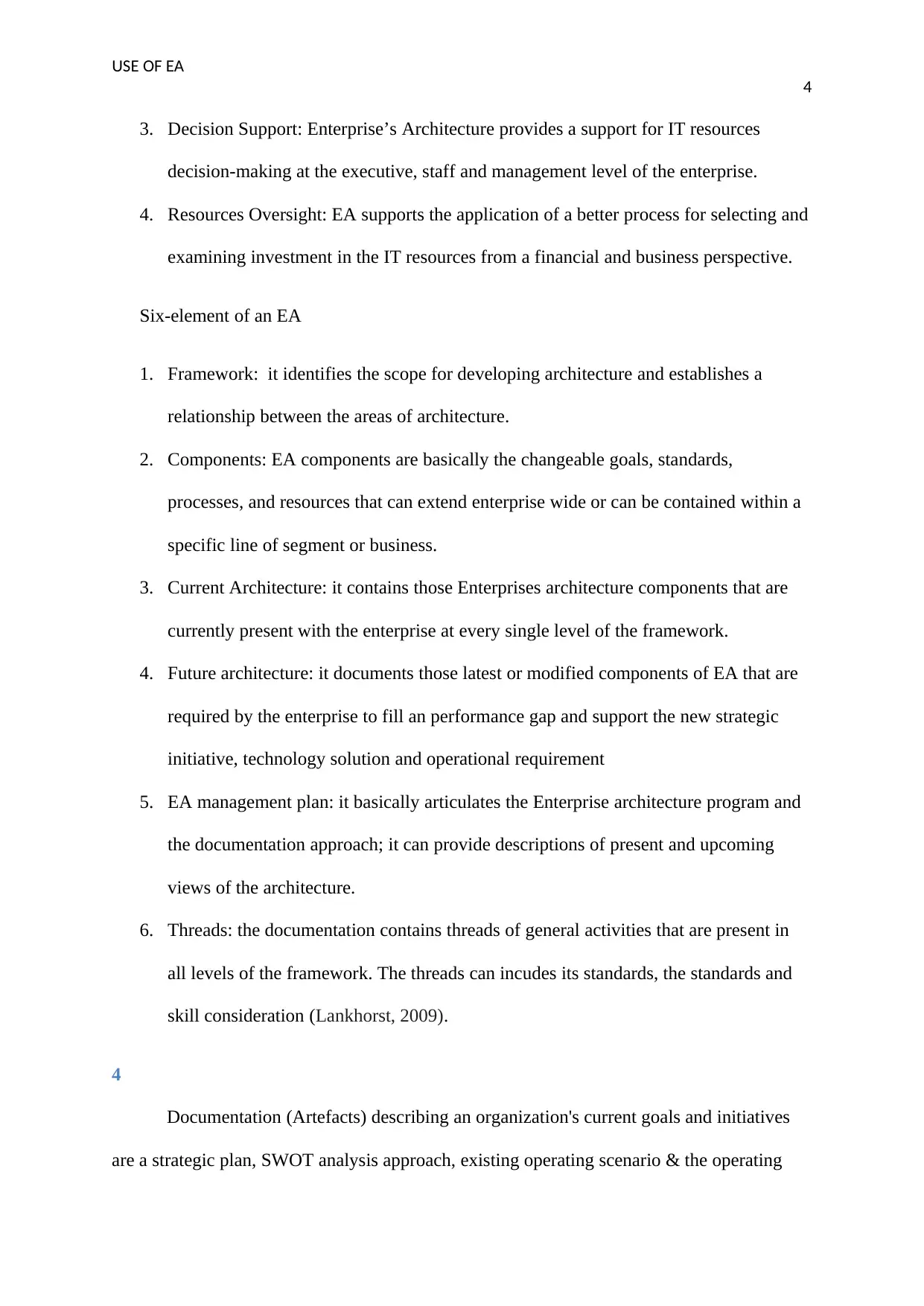
USE OF EA
4
3. Decision Support: Enterprise’s Architecture provides a support for IT resources
decision-making at the executive, staff and management level of the enterprise.
4. Resources Oversight: EA supports the application of a better process for selecting and
examining investment in the IT resources from a financial and business perspective.
Six-element of an EA
1. Framework: it identifies the scope for developing architecture and establishes a
relationship between the areas of architecture.
2. Components: EA components are basically the changeable goals, standards,
processes, and resources that can extend enterprise wide or can be contained within a
specific line of segment or business.
3. Current Architecture: it contains those Enterprises architecture components that are
currently present with the enterprise at every single level of the framework.
4. Future architecture: it documents those latest or modified components of EA that are
required by the enterprise to fill an performance gap and support the new strategic
initiative, technology solution and operational requirement
5. EA management plan: it basically articulates the Enterprise architecture program and
the documentation approach; it can provide descriptions of present and upcoming
views of the architecture.
6. Threads: the documentation contains threads of general activities that are present in
all levels of the framework. The threads can incudes its standards, the standards and
skill consideration (Lankhorst, 2009).
4
Documentation (Artefacts) describing an organization's current goals and initiatives
are a strategic plan, SWOT analysis approach, existing operating scenario & the operating
4
3. Decision Support: Enterprise’s Architecture provides a support for IT resources
decision-making at the executive, staff and management level of the enterprise.
4. Resources Oversight: EA supports the application of a better process for selecting and
examining investment in the IT resources from a financial and business perspective.
Six-element of an EA
1. Framework: it identifies the scope for developing architecture and establishes a
relationship between the areas of architecture.
2. Components: EA components are basically the changeable goals, standards,
processes, and resources that can extend enterprise wide or can be contained within a
specific line of segment or business.
3. Current Architecture: it contains those Enterprises architecture components that are
currently present with the enterprise at every single level of the framework.
4. Future architecture: it documents those latest or modified components of EA that are
required by the enterprise to fill an performance gap and support the new strategic
initiative, technology solution and operational requirement
5. EA management plan: it basically articulates the Enterprise architecture program and
the documentation approach; it can provide descriptions of present and upcoming
views of the architecture.
6. Threads: the documentation contains threads of general activities that are present in
all levels of the framework. The threads can incudes its standards, the standards and
skill consideration (Lankhorst, 2009).
4
Documentation (Artefacts) describing an organization's current goals and initiatives
are a strategic plan, SWOT analysis approach, existing operating scenario & the operating
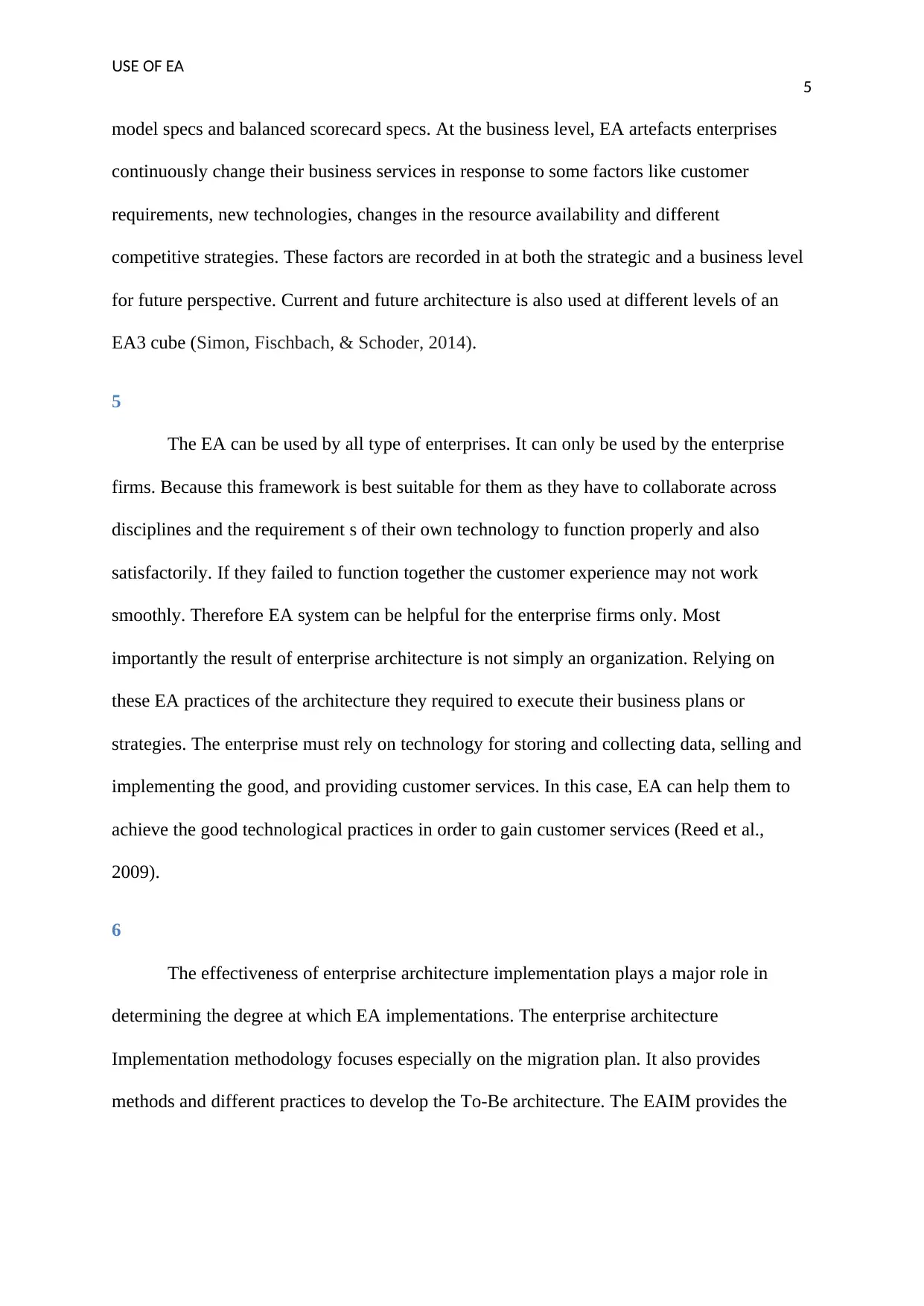
USE OF EA
5
model specs and balanced scorecard specs. At the business level, EA artefacts enterprises
continuously change their business services in response to some factors like customer
requirements, new technologies, changes in the resource availability and different
competitive strategies. These factors are recorded in at both the strategic and a business level
for future perspective. Current and future architecture is also used at different levels of an
EA3 cube (Simon, Fischbach, & Schoder, 2014).
5
The EA can be used by all type of enterprises. It can only be used by the enterprise
firms. Because this framework is best suitable for them as they have to collaborate across
disciplines and the requirement s of their own technology to function properly and also
satisfactorily. If they failed to function together the customer experience may not work
smoothly. Therefore EA system can be helpful for the enterprise firms only. Most
importantly the result of enterprise architecture is not simply an organization. Relying on
these EA practices of the architecture they required to execute their business plans or
strategies. The enterprise must rely on technology for storing and collecting data, selling and
implementing the good, and providing customer services. In this case, EA can help them to
achieve the good technological practices in order to gain customer services (Reed et al.,
2009).
6
The effectiveness of enterprise architecture implementation plays a major role in
determining the degree at which EA implementations. The enterprise architecture
Implementation methodology focuses especially on the migration plan. It also provides
methods and different practices to develop the To-Be architecture. The EAIM provides the
5
model specs and balanced scorecard specs. At the business level, EA artefacts enterprises
continuously change their business services in response to some factors like customer
requirements, new technologies, changes in the resource availability and different
competitive strategies. These factors are recorded in at both the strategic and a business level
for future perspective. Current and future architecture is also used at different levels of an
EA3 cube (Simon, Fischbach, & Schoder, 2014).
5
The EA can be used by all type of enterprises. It can only be used by the enterprise
firms. Because this framework is best suitable for them as they have to collaborate across
disciplines and the requirement s of their own technology to function properly and also
satisfactorily. If they failed to function together the customer experience may not work
smoothly. Therefore EA system can be helpful for the enterprise firms only. Most
importantly the result of enterprise architecture is not simply an organization. Relying on
these EA practices of the architecture they required to execute their business plans or
strategies. The enterprise must rely on technology for storing and collecting data, selling and
implementing the good, and providing customer services. In this case, EA can help them to
achieve the good technological practices in order to gain customer services (Reed et al.,
2009).
6
The effectiveness of enterprise architecture implementation plays a major role in
determining the degree at which EA implementations. The enterprise architecture
Implementation methodology focuses especially on the migration plan. It also provides
methods and different practices to develop the To-Be architecture. The EAIM provides the
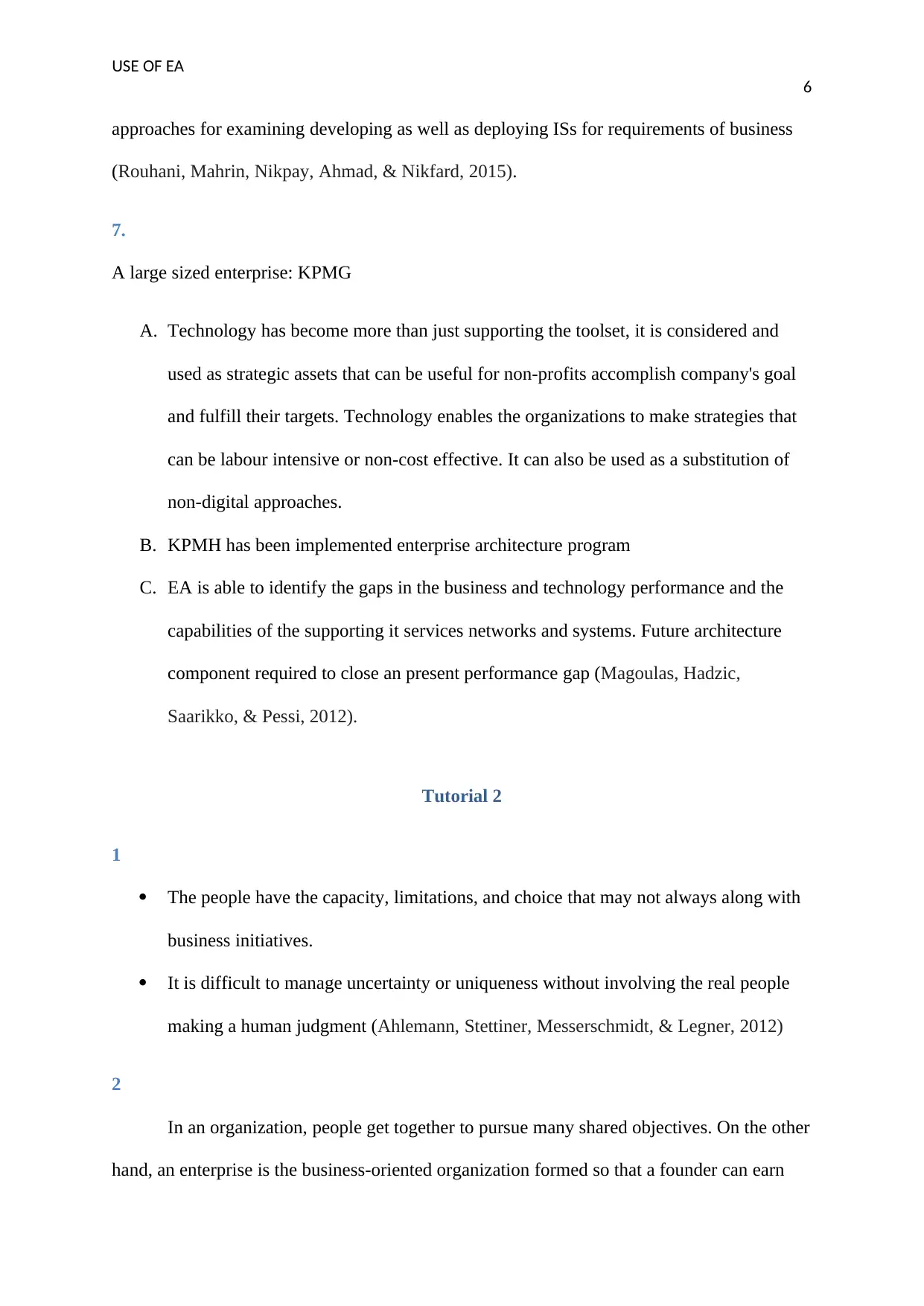
USE OF EA
6
approaches for examining developing as well as deploying ISs for requirements of business
(Rouhani, Mahrin, Nikpay, Ahmad, & Nikfard, 2015).
7.
A large sized enterprise: KPMG
A. Technology has become more than just supporting the toolset, it is considered and
used as strategic assets that can be useful for non-profits accomplish company's goal
and fulfill their targets. Technology enables the organizations to make strategies that
can be labour intensive or non-cost effective. It can also be used as a substitution of
non-digital approaches.
B. KPMH has been implemented enterprise architecture program
C. EA is able to identify the gaps in the business and technology performance and the
capabilities of the supporting it services networks and systems. Future architecture
component required to close an present performance gap (Magoulas, Hadzic,
Saarikko, & Pessi, 2012).
Tutorial 2
1
The people have the capacity, limitations, and choice that may not always along with
business initiatives.
It is difficult to manage uncertainty or uniqueness without involving the real people
making a human judgment (Ahlemann, Stettiner, Messerschmidt, & Legner, 2012)
2
In an organization, people get together to pursue many shared objectives. On the other
hand, an enterprise is the business-oriented organization formed so that a founder can earn
6
approaches for examining developing as well as deploying ISs for requirements of business
(Rouhani, Mahrin, Nikpay, Ahmad, & Nikfard, 2015).
7.
A large sized enterprise: KPMG
A. Technology has become more than just supporting the toolset, it is considered and
used as strategic assets that can be useful for non-profits accomplish company's goal
and fulfill their targets. Technology enables the organizations to make strategies that
can be labour intensive or non-cost effective. It can also be used as a substitution of
non-digital approaches.
B. KPMH has been implemented enterprise architecture program
C. EA is able to identify the gaps in the business and technology performance and the
capabilities of the supporting it services networks and systems. Future architecture
component required to close an present performance gap (Magoulas, Hadzic,
Saarikko, & Pessi, 2012).
Tutorial 2
1
The people have the capacity, limitations, and choice that may not always along with
business initiatives.
It is difficult to manage uncertainty or uniqueness without involving the real people
making a human judgment (Ahlemann, Stettiner, Messerschmidt, & Legner, 2012)
2
In an organization, people get together to pursue many shared objectives. On the other
hand, an enterprise is the business-oriented organization formed so that a founder can earn
Paraphrase This Document
Need a fresh take? Get an instant paraphrase of this document with our AI Paraphraser

USE OF EA
7
profits. A community group which is formed for planning an event is also considered a
formal organization. Purpose of the enterprise is to attract clients, services, earning profits
and selling goods. Example of an organization is a group of friends that formed an
organization when they initiate a social club. On the other hand, enterprises are different from
clubs or other non-commercial organization because of their entrepreneurial purposes.
Organisation and enterprise both are formal and informal. A formal organization has a
structure or element. The employees that meet in the break every day for lunch form an
informal organization. Formal enterprises may include partnerships, less liable companies,
joint ventures, corporations, and the S- corporations. An enterprise is either formal or
informal. It is more commonly used in reference to informal entrepreneurial activities. In an
organization when there is no official leader, the more dominant person would likely to direct
the conversation. The organization can be affected by both internal and external influences
(Webb, Kistruck, Ireland & Ketchen Jr, 2010).
3
Some of the academic areas that can influence the fields of EA are Business
management, IT management and IT governance (Enterprise Architect, 2015).
4
Technical level: This part of the company or organization carrying on the production function
which can transform the inputs into outputs.
The managerial level: this level of the organization responsible for controlling and designing
the production system in order to procure the inputs and disposing of outputs.
Institutional level: in this part of the organization the organizations relates to its diverse
environment, establishes its boundaries, determines its domain and secures its legitimacy
(Baporikar, 2013).
7
profits. A community group which is formed for planning an event is also considered a
formal organization. Purpose of the enterprise is to attract clients, services, earning profits
and selling goods. Example of an organization is a group of friends that formed an
organization when they initiate a social club. On the other hand, enterprises are different from
clubs or other non-commercial organization because of their entrepreneurial purposes.
Organisation and enterprise both are formal and informal. A formal organization has a
structure or element. The employees that meet in the break every day for lunch form an
informal organization. Formal enterprises may include partnerships, less liable companies,
joint ventures, corporations, and the S- corporations. An enterprise is either formal or
informal. It is more commonly used in reference to informal entrepreneurial activities. In an
organization when there is no official leader, the more dominant person would likely to direct
the conversation. The organization can be affected by both internal and external influences
(Webb, Kistruck, Ireland & Ketchen Jr, 2010).
3
Some of the academic areas that can influence the fields of EA are Business
management, IT management and IT governance (Enterprise Architect, 2015).
4
Technical level: This part of the company or organization carrying on the production function
which can transform the inputs into outputs.
The managerial level: this level of the organization responsible for controlling and designing
the production system in order to procure the inputs and disposing of outputs.
Institutional level: in this part of the organization the organizations relates to its diverse
environment, establishes its boundaries, determines its domain and secures its legitimacy
(Baporikar, 2013).
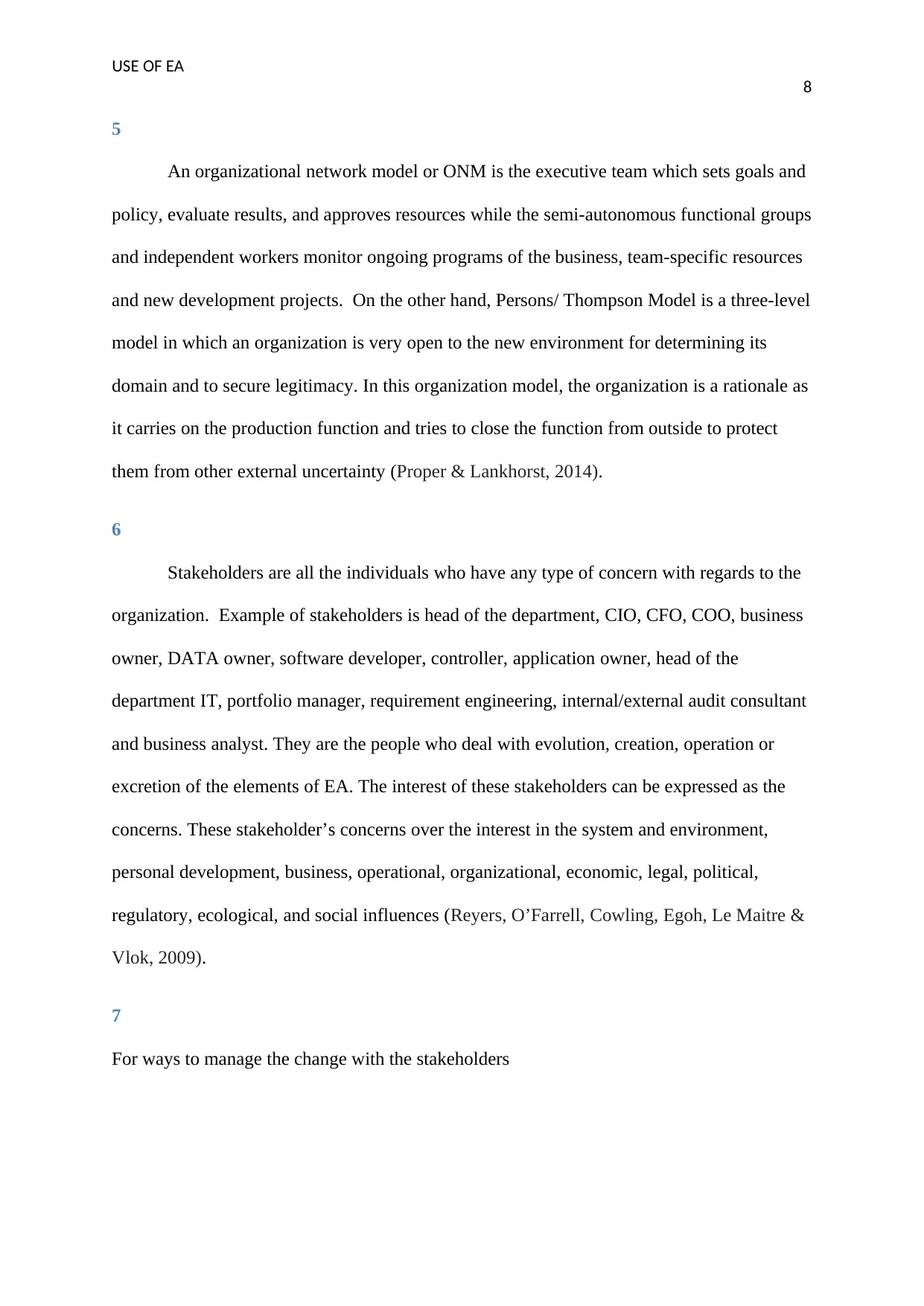
USE OF EA
8
5
An organizational network model or ONM is the executive team which sets goals and
policy, evaluate results, and approves resources while the semi-autonomous functional groups
and independent workers monitor ongoing programs of the business, team-specific resources
and new development projects. On the other hand, Persons/ Thompson Model is a three-level
model in which an organization is very open to the new environment for determining its
domain and to secure legitimacy. In this organization model, the organization is a rationale as
it carries on the production function and tries to close the function from outside to protect
them from other external uncertainty (Proper & Lankhorst, 2014).
6
Stakeholders are all the individuals who have any type of concern with regards to the
organization. Example of stakeholders is head of the department, CIO, CFO, COO, business
owner, DATA owner, software developer, controller, application owner, head of the
department IT, portfolio manager, requirement engineering, internal/external audit consultant
and business analyst. They are the people who deal with evolution, creation, operation or
excretion of the elements of EA. The interest of these stakeholders can be expressed as the
concerns. These stakeholder’s concerns over the interest in the system and environment,
personal development, business, operational, organizational, economic, legal, political,
regulatory, ecological, and social influences (Reyers, O’Farrell, Cowling, Egoh, Le Maitre &
Vlok, 2009).
7
For ways to manage the change with the stakeholders
8
5
An organizational network model or ONM is the executive team which sets goals and
policy, evaluate results, and approves resources while the semi-autonomous functional groups
and independent workers monitor ongoing programs of the business, team-specific resources
and new development projects. On the other hand, Persons/ Thompson Model is a three-level
model in which an organization is very open to the new environment for determining its
domain and to secure legitimacy. In this organization model, the organization is a rationale as
it carries on the production function and tries to close the function from outside to protect
them from other external uncertainty (Proper & Lankhorst, 2014).
6
Stakeholders are all the individuals who have any type of concern with regards to the
organization. Example of stakeholders is head of the department, CIO, CFO, COO, business
owner, DATA owner, software developer, controller, application owner, head of the
department IT, portfolio manager, requirement engineering, internal/external audit consultant
and business analyst. They are the people who deal with evolution, creation, operation or
excretion of the elements of EA. The interest of these stakeholders can be expressed as the
concerns. These stakeholder’s concerns over the interest in the system and environment,
personal development, business, operational, organizational, economic, legal, political,
regulatory, ecological, and social influences (Reyers, O’Farrell, Cowling, Egoh, Le Maitre &
Vlok, 2009).
7
For ways to manage the change with the stakeholders
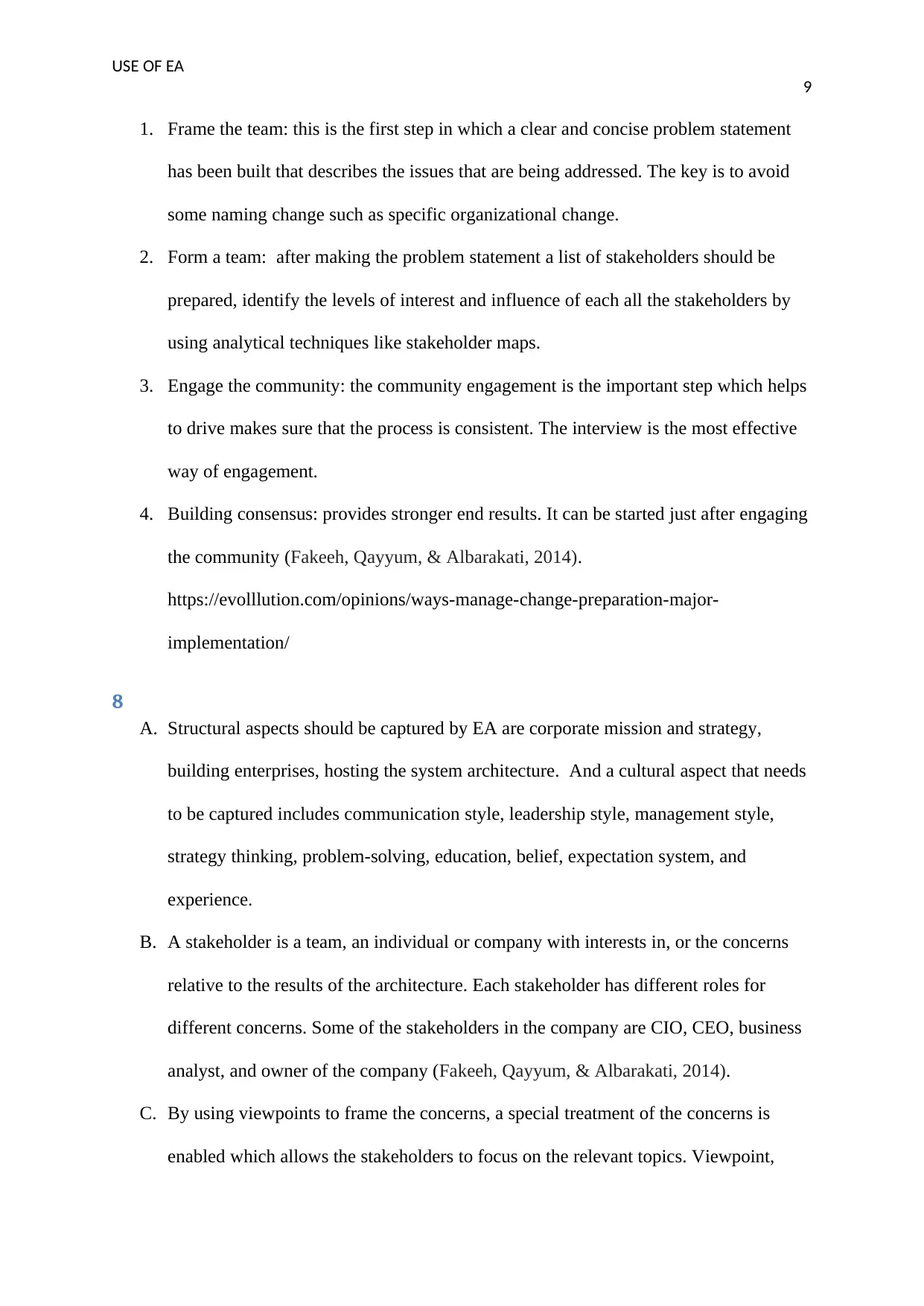
USE OF EA
9
1. Frame the team: this is the first step in which a clear and concise problem statement
has been built that describes the issues that are being addressed. The key is to avoid
some naming change such as specific organizational change.
2. Form a team: after making the problem statement a list of stakeholders should be
prepared, identify the levels of interest and influence of each all the stakeholders by
using analytical techniques like stakeholder maps.
3. Engage the community: the community engagement is the important step which helps
to drive makes sure that the process is consistent. The interview is the most effective
way of engagement.
4. Building consensus: provides stronger end results. It can be started just after engaging
the community (Fakeeh, Qayyum, & Albarakati, 2014).
https://evolllution.com/opinions/ways-manage-change-preparation-major-
implementation/
8
A. Structural aspects should be captured by EA are corporate mission and strategy,
building enterprises, hosting the system architecture. And a cultural aspect that needs
to be captured includes communication style, leadership style, management style,
strategy thinking, problem-solving, education, belief, expectation system, and
experience.
B. A stakeholder is a team, an individual or company with interests in, or the concerns
relative to the results of the architecture. Each stakeholder has different roles for
different concerns. Some of the stakeholders in the company are CIO, CEO, business
analyst, and owner of the company (Fakeeh, Qayyum, & Albarakati, 2014).
C. By using viewpoints to frame the concerns, a special treatment of the concerns is
enabled which allows the stakeholders to focus on the relevant topics. Viewpoint,
9
1. Frame the team: this is the first step in which a clear and concise problem statement
has been built that describes the issues that are being addressed. The key is to avoid
some naming change such as specific organizational change.
2. Form a team: after making the problem statement a list of stakeholders should be
prepared, identify the levels of interest and influence of each all the stakeholders by
using analytical techniques like stakeholder maps.
3. Engage the community: the community engagement is the important step which helps
to drive makes sure that the process is consistent. The interview is the most effective
way of engagement.
4. Building consensus: provides stronger end results. It can be started just after engaging
the community (Fakeeh, Qayyum, & Albarakati, 2014).
https://evolllution.com/opinions/ways-manage-change-preparation-major-
implementation/
8
A. Structural aspects should be captured by EA are corporate mission and strategy,
building enterprises, hosting the system architecture. And a cultural aspect that needs
to be captured includes communication style, leadership style, management style,
strategy thinking, problem-solving, education, belief, expectation system, and
experience.
B. A stakeholder is a team, an individual or company with interests in, or the concerns
relative to the results of the architecture. Each stakeholder has different roles for
different concerns. Some of the stakeholders in the company are CIO, CEO, business
analyst, and owner of the company (Fakeeh, Qayyum, & Albarakati, 2014).
C. By using viewpoints to frame the concerns, a special treatment of the concerns is
enabled which allows the stakeholders to focus on the relevant topics. Viewpoint,
Secure Best Marks with AI Grader
Need help grading? Try our AI Grader for instant feedback on your assignments.
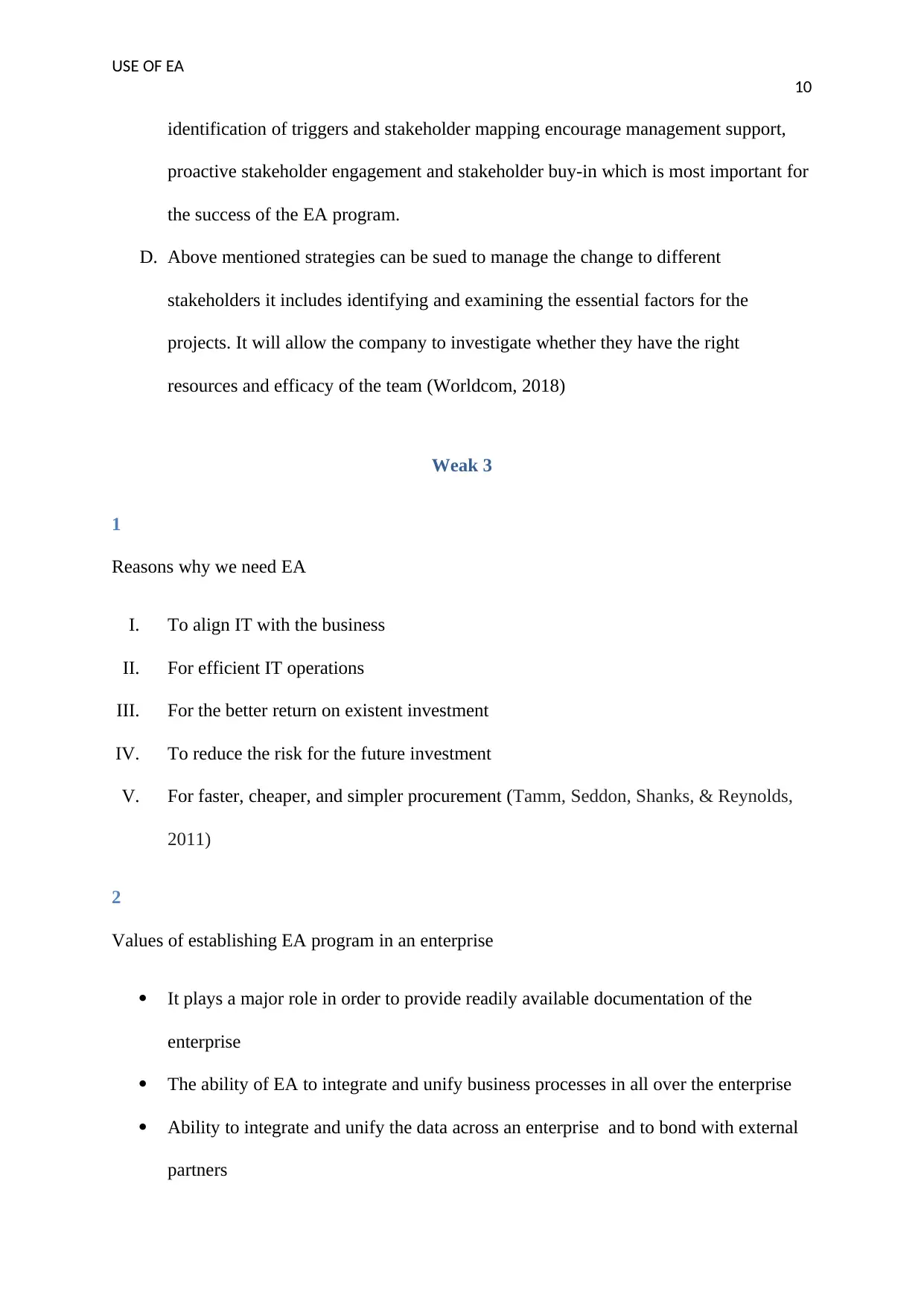
USE OF EA
10
identification of triggers and stakeholder mapping encourage management support,
proactive stakeholder engagement and stakeholder buy-in which is most important for
the success of the EA program.
D. Above mentioned strategies can be sued to manage the change to different
stakeholders it includes identifying and examining the essential factors for the
projects. It will allow the company to investigate whether they have the right
resources and efficacy of the team (Worldcom, 2018)
Weak 3
1
Reasons why we need EA
I. To align IT with the business
II. For efficient IT operations
III. For the better return on existent investment
IV. To reduce the risk for the future investment
V. For faster, cheaper, and simpler procurement (Tamm, Seddon, Shanks, & Reynolds,
2011)
2
Values of establishing EA program in an enterprise
It plays a major role in order to provide readily available documentation of the
enterprise
The ability of EA to integrate and unify business processes in all over the enterprise
Ability to integrate and unify the data across an enterprise and to bond with external
partners
10
identification of triggers and stakeholder mapping encourage management support,
proactive stakeholder engagement and stakeholder buy-in which is most important for
the success of the EA program.
D. Above mentioned strategies can be sued to manage the change to different
stakeholders it includes identifying and examining the essential factors for the
projects. It will allow the company to investigate whether they have the right
resources and efficacy of the team (Worldcom, 2018)
Weak 3
1
Reasons why we need EA
I. To align IT with the business
II. For efficient IT operations
III. For the better return on existent investment
IV. To reduce the risk for the future investment
V. For faster, cheaper, and simpler procurement (Tamm, Seddon, Shanks, & Reynolds,
2011)
2
Values of establishing EA program in an enterprise
It plays a major role in order to provide readily available documentation of the
enterprise
The ability of EA to integrate and unify business processes in all over the enterprise
Ability to integrate and unify the data across an enterprise and to bond with external
partners
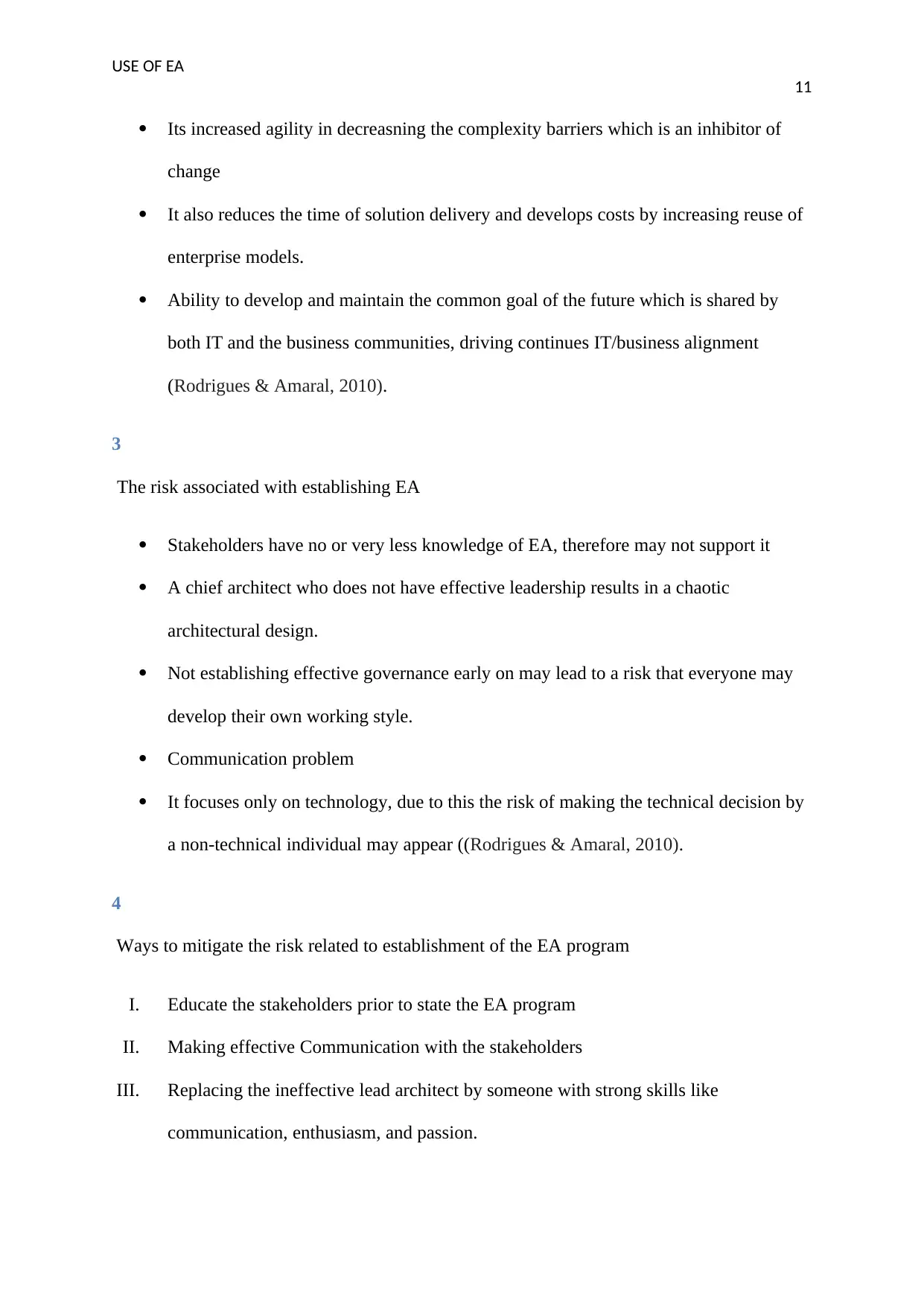
USE OF EA
11
Its increased agility in decreasning the complexity barriers which is an inhibitor of
change
It also reduces the time of solution delivery and develops costs by increasing reuse of
enterprise models.
Ability to develop and maintain the common goal of the future which is shared by
both IT and the business communities, driving continues IT/business alignment
(Rodrigues & Amaral, 2010).
3
The risk associated with establishing EA
Stakeholders have no or very less knowledge of EA, therefore may not support it
A chief architect who does not have effective leadership results in a chaotic
architectural design.
Not establishing effective governance early on may lead to a risk that everyone may
develop their own working style.
Communication problem
It focuses only on technology, due to this the risk of making the technical decision by
a non-technical individual may appear ((Rodrigues & Amaral, 2010).
4
Ways to mitigate the risk related to establishment of the EA program
I. Educate the stakeholders prior to state the EA program
II. Making effective Communication with the stakeholders
III. Replacing the ineffective lead architect by someone with strong skills like
communication, enthusiasm, and passion.
11
Its increased agility in decreasning the complexity barriers which is an inhibitor of
change
It also reduces the time of solution delivery and develops costs by increasing reuse of
enterprise models.
Ability to develop and maintain the common goal of the future which is shared by
both IT and the business communities, driving continues IT/business alignment
(Rodrigues & Amaral, 2010).
3
The risk associated with establishing EA
Stakeholders have no or very less knowledge of EA, therefore may not support it
A chief architect who does not have effective leadership results in a chaotic
architectural design.
Not establishing effective governance early on may lead to a risk that everyone may
develop their own working style.
Communication problem
It focuses only on technology, due to this the risk of making the technical decision by
a non-technical individual may appear ((Rodrigues & Amaral, 2010).
4
Ways to mitigate the risk related to establishment of the EA program
I. Educate the stakeholders prior to state the EA program
II. Making effective Communication with the stakeholders
III. Replacing the ineffective lead architect by someone with strong skills like
communication, enthusiasm, and passion.
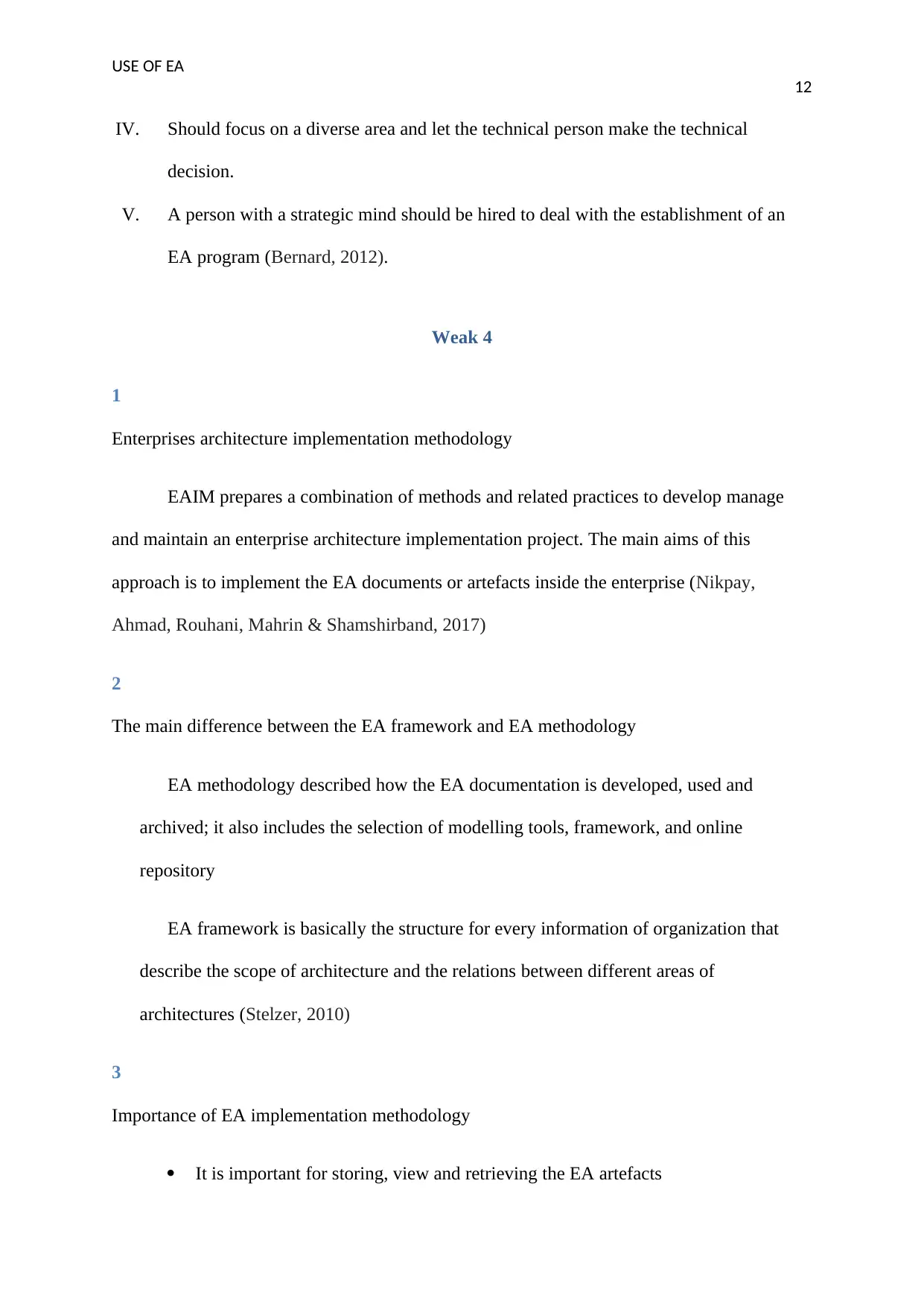
USE OF EA
12
IV. Should focus on a diverse area and let the technical person make the technical
decision.
V. A person with a strategic mind should be hired to deal with the establishment of an
EA program (Bernard, 2012).
Weak 4
1
Enterprises architecture implementation methodology
EAIM prepares a combination of methods and related practices to develop manage
and maintain an enterprise architecture implementation project. The main aims of this
approach is to implement the EA documents or artefacts inside the enterprise (Nikpay,
Ahmad, Rouhani, Mahrin & Shamshirband, 2017)
2
The main difference between the EA framework and EA methodology
EA methodology described how the EA documentation is developed, used and
archived; it also includes the selection of modelling tools, framework, and online
repository
EA framework is basically the structure for every information of organization that
describe the scope of architecture and the relations between different areas of
architectures (Stelzer, 2010)
3
Importance of EA implementation methodology
It is important for storing, view and retrieving the EA artefacts
12
IV. Should focus on a diverse area and let the technical person make the technical
decision.
V. A person with a strategic mind should be hired to deal with the establishment of an
EA program (Bernard, 2012).
Weak 4
1
Enterprises architecture implementation methodology
EAIM prepares a combination of methods and related practices to develop manage
and maintain an enterprise architecture implementation project. The main aims of this
approach is to implement the EA documents or artefacts inside the enterprise (Nikpay,
Ahmad, Rouhani, Mahrin & Shamshirband, 2017)
2
The main difference between the EA framework and EA methodology
EA methodology described how the EA documentation is developed, used and
archived; it also includes the selection of modelling tools, framework, and online
repository
EA framework is basically the structure for every information of organization that
describe the scope of architecture and the relations between different areas of
architectures (Stelzer, 2010)
3
Importance of EA implementation methodology
It is important for storing, view and retrieving the EA artefacts
Paraphrase This Document
Need a fresh take? Get an instant paraphrase of this document with our AI Paraphraser
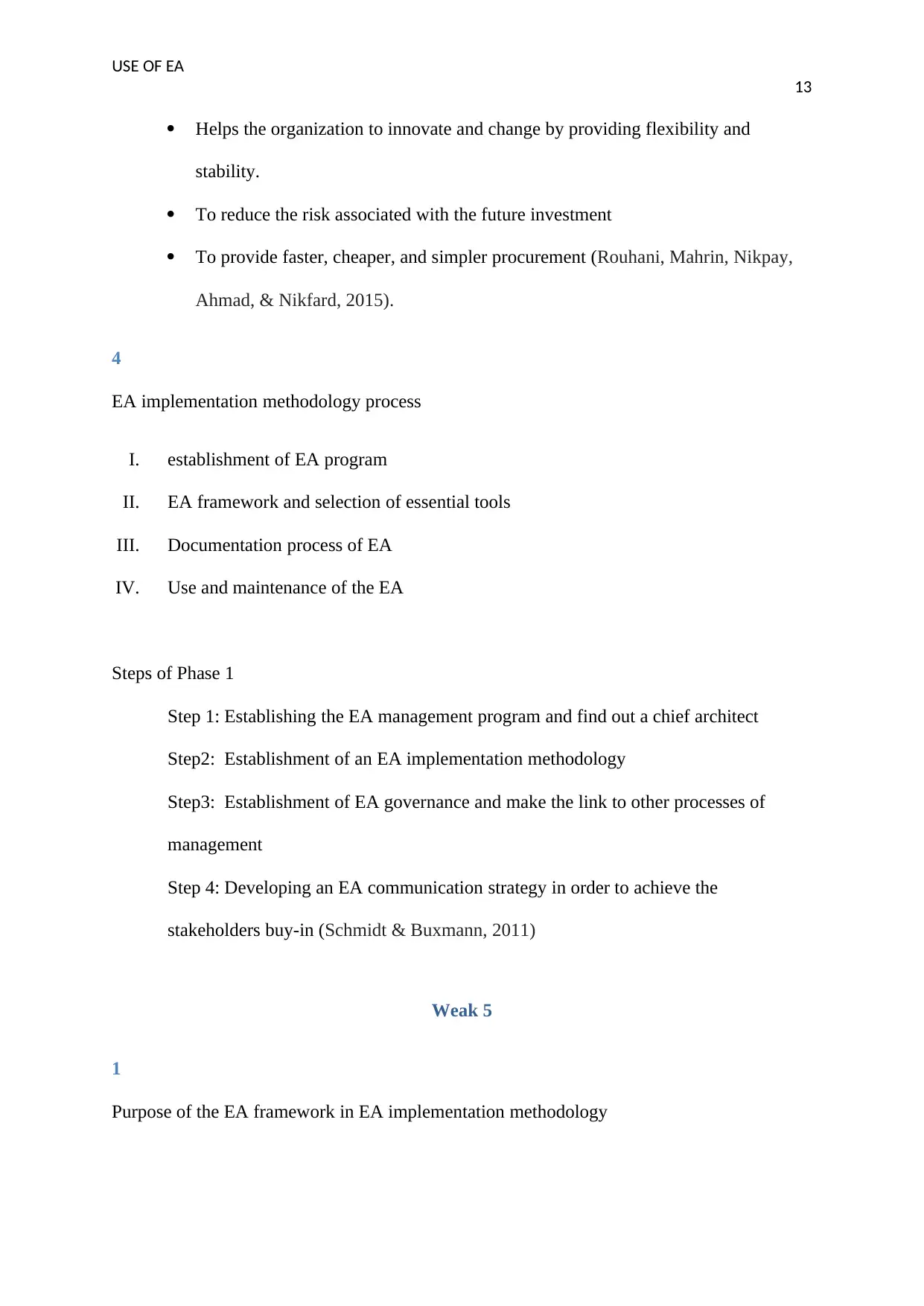
USE OF EA
13
Helps the organization to innovate and change by providing flexibility and
stability.
To reduce the risk associated with the future investment
To provide faster, cheaper, and simpler procurement (Rouhani, Mahrin, Nikpay,
Ahmad, & Nikfard, 2015).
4
EA implementation methodology process
I. establishment of EA program
II. EA framework and selection of essential tools
III. Documentation process of EA
IV. Use and maintenance of the EA
Steps of Phase 1
Step 1: Establishing the EA management program and find out a chief architect
Step2: Establishment of an EA implementation methodology
Step3: Establishment of EA governance and make the link to other processes of
management
Step 4: Developing an EA communication strategy in order to achieve the
stakeholders buy-in (Schmidt & Buxmann, 2011)
Weak 5
1
Purpose of the EA framework in EA implementation methodology
13
Helps the organization to innovate and change by providing flexibility and
stability.
To reduce the risk associated with the future investment
To provide faster, cheaper, and simpler procurement (Rouhani, Mahrin, Nikpay,
Ahmad, & Nikfard, 2015).
4
EA implementation methodology process
I. establishment of EA program
II. EA framework and selection of essential tools
III. Documentation process of EA
IV. Use and maintenance of the EA
Steps of Phase 1
Step 1: Establishing the EA management program and find out a chief architect
Step2: Establishment of an EA implementation methodology
Step3: Establishment of EA governance and make the link to other processes of
management
Step 4: Developing an EA communication strategy in order to achieve the
stakeholders buy-in (Schmidt & Buxmann, 2011)
Weak 5
1
Purpose of the EA framework in EA implementation methodology
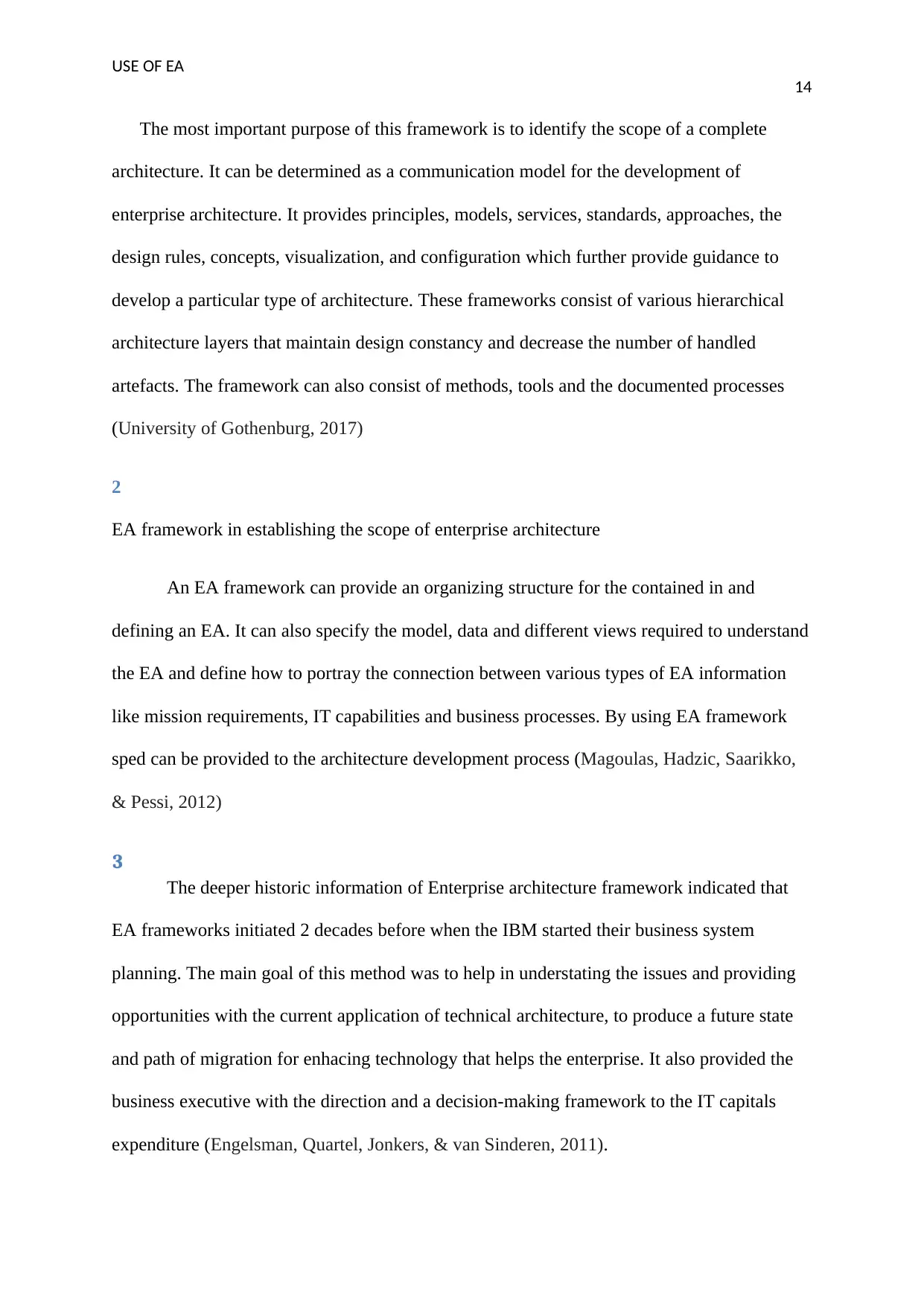
USE OF EA
14
The most important purpose of this framework is to identify the scope of a complete
architecture. It can be determined as a communication model for the development of
enterprise architecture. It provides principles, models, services, standards, approaches, the
design rules, concepts, visualization, and configuration which further provide guidance to
develop a particular type of architecture. These frameworks consist of various hierarchical
architecture layers that maintain design constancy and decrease the number of handled
artefacts. The framework can also consist of methods, tools and the documented processes
(University of Gothenburg, 2017)
2
EA framework in establishing the scope of enterprise architecture
An EA framework can provide an organizing structure for the contained in and
defining an EA. It can also specify the model, data and different views required to understand
the EA and define how to portray the connection between various types of EA information
like mission requirements, IT capabilities and business processes. By using EA framework
sped can be provided to the architecture development process (Magoulas, Hadzic, Saarikko,
& Pessi, 2012)
3
The deeper historic information of Enterprise architecture framework indicated that
EA frameworks initiated 2 decades before when the IBM started their business system
planning. The main goal of this method was to help in understating the issues and providing
opportunities with the current application of technical architecture, to produce a future state
and path of migration for enhacing technology that helps the enterprise. It also provided the
business executive with the direction and a decision-making framework to the IT capitals
expenditure (Engelsman, Quartel, Jonkers, & van Sinderen, 2011).
14
The most important purpose of this framework is to identify the scope of a complete
architecture. It can be determined as a communication model for the development of
enterprise architecture. It provides principles, models, services, standards, approaches, the
design rules, concepts, visualization, and configuration which further provide guidance to
develop a particular type of architecture. These frameworks consist of various hierarchical
architecture layers that maintain design constancy and decrease the number of handled
artefacts. The framework can also consist of methods, tools and the documented processes
(University of Gothenburg, 2017)
2
EA framework in establishing the scope of enterprise architecture
An EA framework can provide an organizing structure for the contained in and
defining an EA. It can also specify the model, data and different views required to understand
the EA and define how to portray the connection between various types of EA information
like mission requirements, IT capabilities and business processes. By using EA framework
sped can be provided to the architecture development process (Magoulas, Hadzic, Saarikko,
& Pessi, 2012)
3
The deeper historic information of Enterprise architecture framework indicated that
EA frameworks initiated 2 decades before when the IBM started their business system
planning. The main goal of this method was to help in understating the issues and providing
opportunities with the current application of technical architecture, to produce a future state
and path of migration for enhacing technology that helps the enterprise. It also provided the
business executive with the direction and a decision-making framework to the IT capitals
expenditure (Engelsman, Quartel, Jonkers, & van Sinderen, 2011).
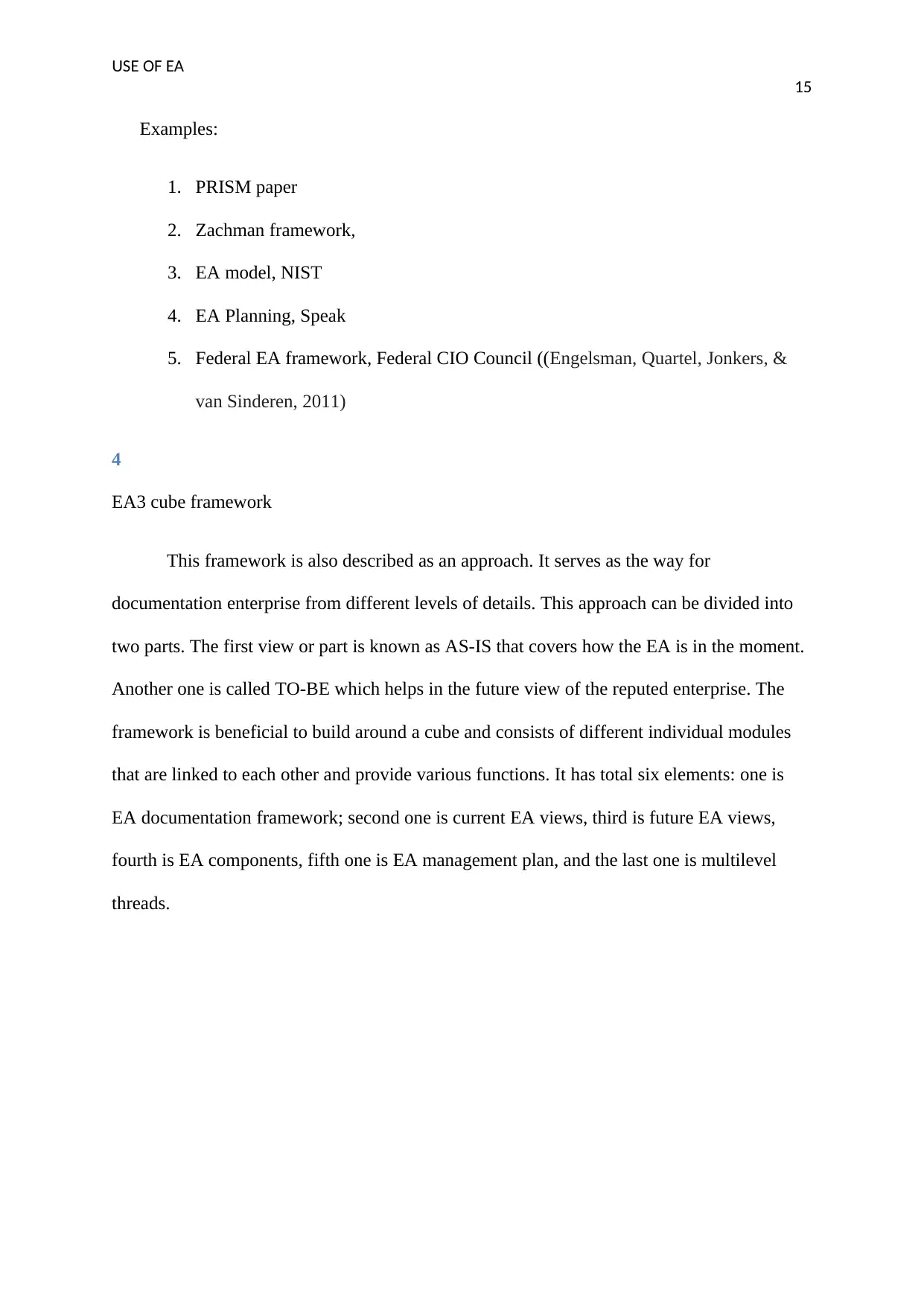
USE OF EA
15
Examples:
1. PRISM paper
2. Zachman framework,
3. EA model, NIST
4. EA Planning, Speak
5. Federal EA framework, Federal CIO Council ((Engelsman, Quartel, Jonkers, &
van Sinderen, 2011)
4
EA3 cube framework
This framework is also described as an approach. It serves as the way for
documentation enterprise from different levels of details. This approach can be divided into
two parts. The first view or part is known as AS-IS that covers how the EA is in the moment.
Another one is called TO-BE which helps in the future view of the reputed enterprise. The
framework is beneficial to build around a cube and consists of different individual modules
that are linked to each other and provide various functions. It has total six elements: one is
EA documentation framework; second one is current EA views, third is future EA views,
fourth is EA components, fifth one is EA management plan, and the last one is multilevel
threads.
15
Examples:
1. PRISM paper
2. Zachman framework,
3. EA model, NIST
4. EA Planning, Speak
5. Federal EA framework, Federal CIO Council ((Engelsman, Quartel, Jonkers, &
van Sinderen, 2011)
4
EA3 cube framework
This framework is also described as an approach. It serves as the way for
documentation enterprise from different levels of details. This approach can be divided into
two parts. The first view or part is known as AS-IS that covers how the EA is in the moment.
Another one is called TO-BE which helps in the future view of the reputed enterprise. The
framework is beneficial to build around a cube and consists of different individual modules
that are linked to each other and provide various functions. It has total six elements: one is
EA documentation framework; second one is current EA views, third is future EA views,
fourth is EA components, fifth one is EA management plan, and the last one is multilevel
threads.
Secure Best Marks with AI Grader
Need help grading? Try our AI Grader for instant feedback on your assignments.
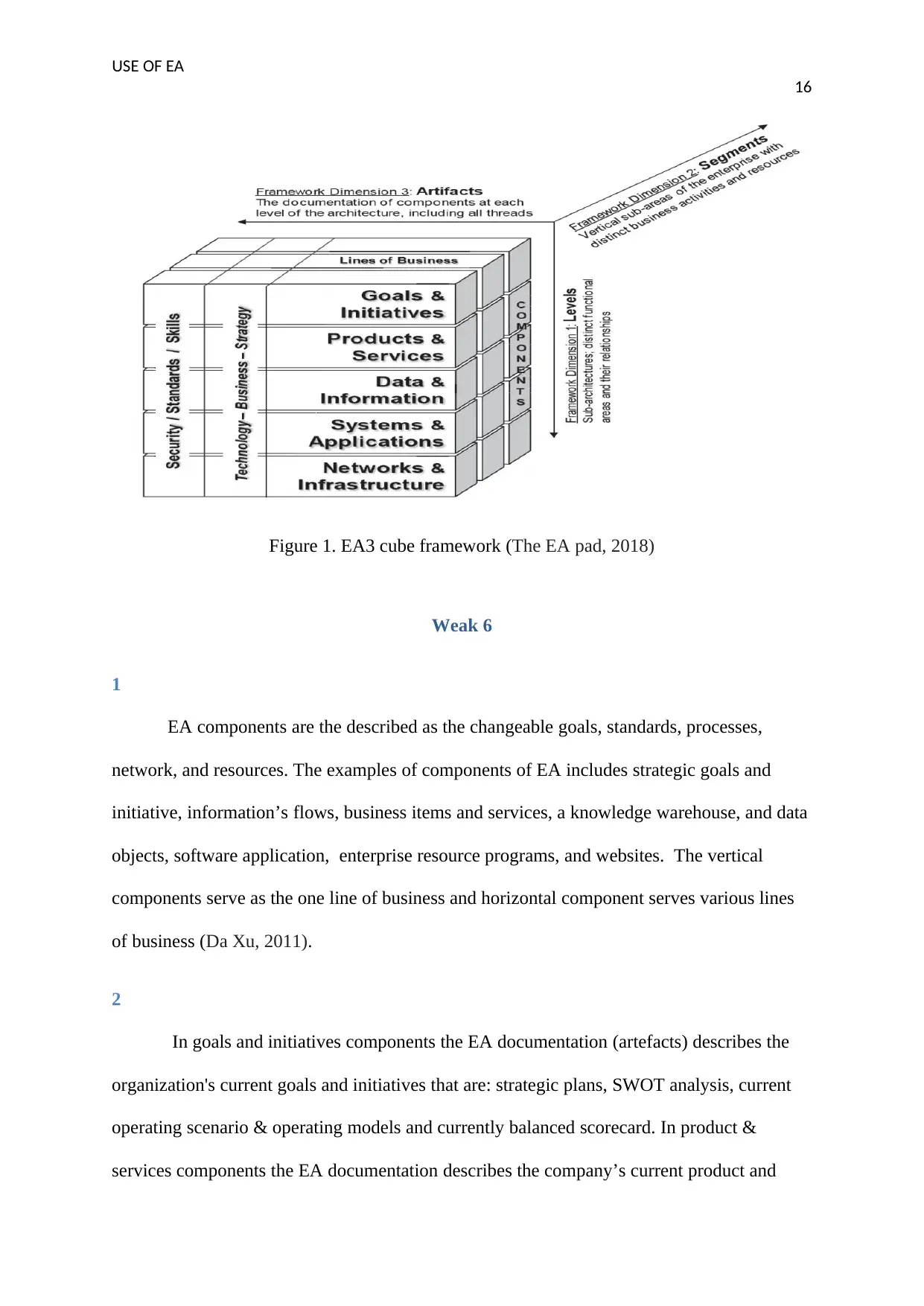
USE OF EA
16
Figure 1. EA3 cube framework (The EA pad, 2018)
Weak 6
1
EA components are the described as the changeable goals, standards, processes,
network, and resources. The examples of components of EA includes strategic goals and
initiative, information’s flows, business items and services, a knowledge warehouse, and data
objects, software application, enterprise resource programs, and websites. The vertical
components serve as the one line of business and horizontal component serves various lines
of business (Da Xu, 2011).
2
In goals and initiatives components the EA documentation (artefacts) describes the
organization's current goals and initiatives that are: strategic plans, SWOT analysis, current
operating scenario & operating models and currently balanced scorecard. In product &
services components the EA documentation describes the company’s current product and
16
Figure 1. EA3 cube framework (The EA pad, 2018)
Weak 6
1
EA components are the described as the changeable goals, standards, processes,
network, and resources. The examples of components of EA includes strategic goals and
initiative, information’s flows, business items and services, a knowledge warehouse, and data
objects, software application, enterprise resource programs, and websites. The vertical
components serve as the one line of business and horizontal component serves various lines
of business (Da Xu, 2011).
2
In goals and initiatives components the EA documentation (artefacts) describes the
organization's current goals and initiatives that are: strategic plans, SWOT analysis, current
operating scenario & operating models and currently balanced scorecard. In product &
services components the EA documentation describes the company’s current product and
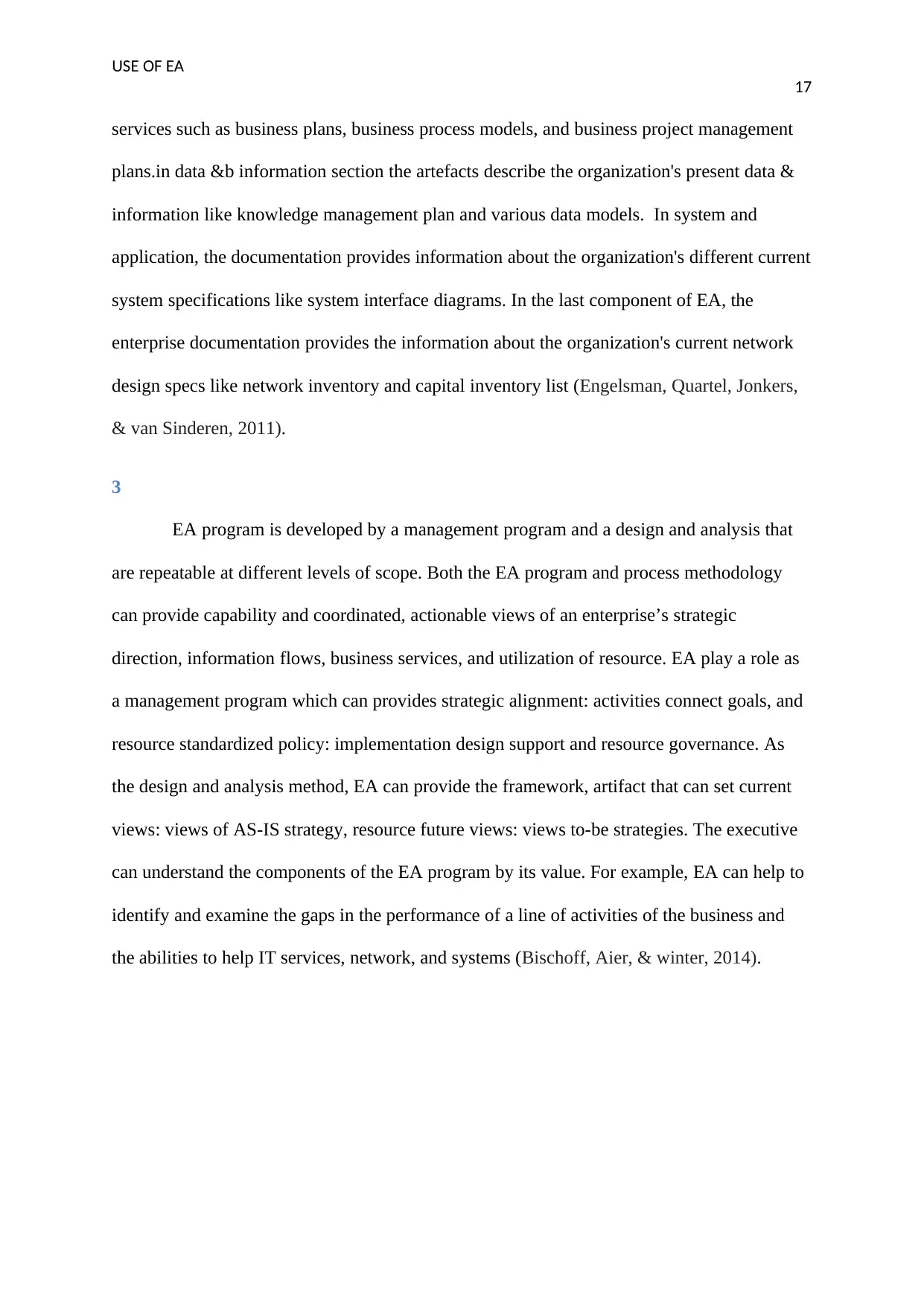
USE OF EA
17
services such as business plans, business process models, and business project management
plans.in data &b information section the artefacts describe the organization's present data &
information like knowledge management plan and various data models. In system and
application, the documentation provides information about the organization's different current
system specifications like system interface diagrams. In the last component of EA, the
enterprise documentation provides the information about the organization's current network
design specs like network inventory and capital inventory list (Engelsman, Quartel, Jonkers,
& van Sinderen, 2011).
3
EA program is developed by a management program and a design and analysis that
are repeatable at different levels of scope. Both the EA program and process methodology
can provide capability and coordinated, actionable views of an enterprise’s strategic
direction, information flows, business services, and utilization of resource. EA play a role as
a management program which can provides strategic alignment: activities connect goals, and
resource standardized policy: implementation design support and resource governance. As
the design and analysis method, EA can provide the framework, artifact that can set current
views: views of AS-IS strategy, resource future views: views to-be strategies. The executive
can understand the components of the EA program by its value. For example, EA can help to
identify and examine the gaps in the performance of a line of activities of the business and
the abilities to help IT services, network, and systems (Bischoff, Aier, & winter, 2014).
17
services such as business plans, business process models, and business project management
plans.in data &b information section the artefacts describe the organization's present data &
information like knowledge management plan and various data models. In system and
application, the documentation provides information about the organization's different current
system specifications like system interface diagrams. In the last component of EA, the
enterprise documentation provides the information about the organization's current network
design specs like network inventory and capital inventory list (Engelsman, Quartel, Jonkers,
& van Sinderen, 2011).
3
EA program is developed by a management program and a design and analysis that
are repeatable at different levels of scope. Both the EA program and process methodology
can provide capability and coordinated, actionable views of an enterprise’s strategic
direction, information flows, business services, and utilization of resource. EA play a role as
a management program which can provides strategic alignment: activities connect goals, and
resource standardized policy: implementation design support and resource governance. As
the design and analysis method, EA can provide the framework, artifact that can set current
views: views of AS-IS strategy, resource future views: views to-be strategies. The executive
can understand the components of the EA program by its value. For example, EA can help to
identify and examine the gaps in the performance of a line of activities of the business and
the abilities to help IT services, network, and systems (Bischoff, Aier, & winter, 2014).
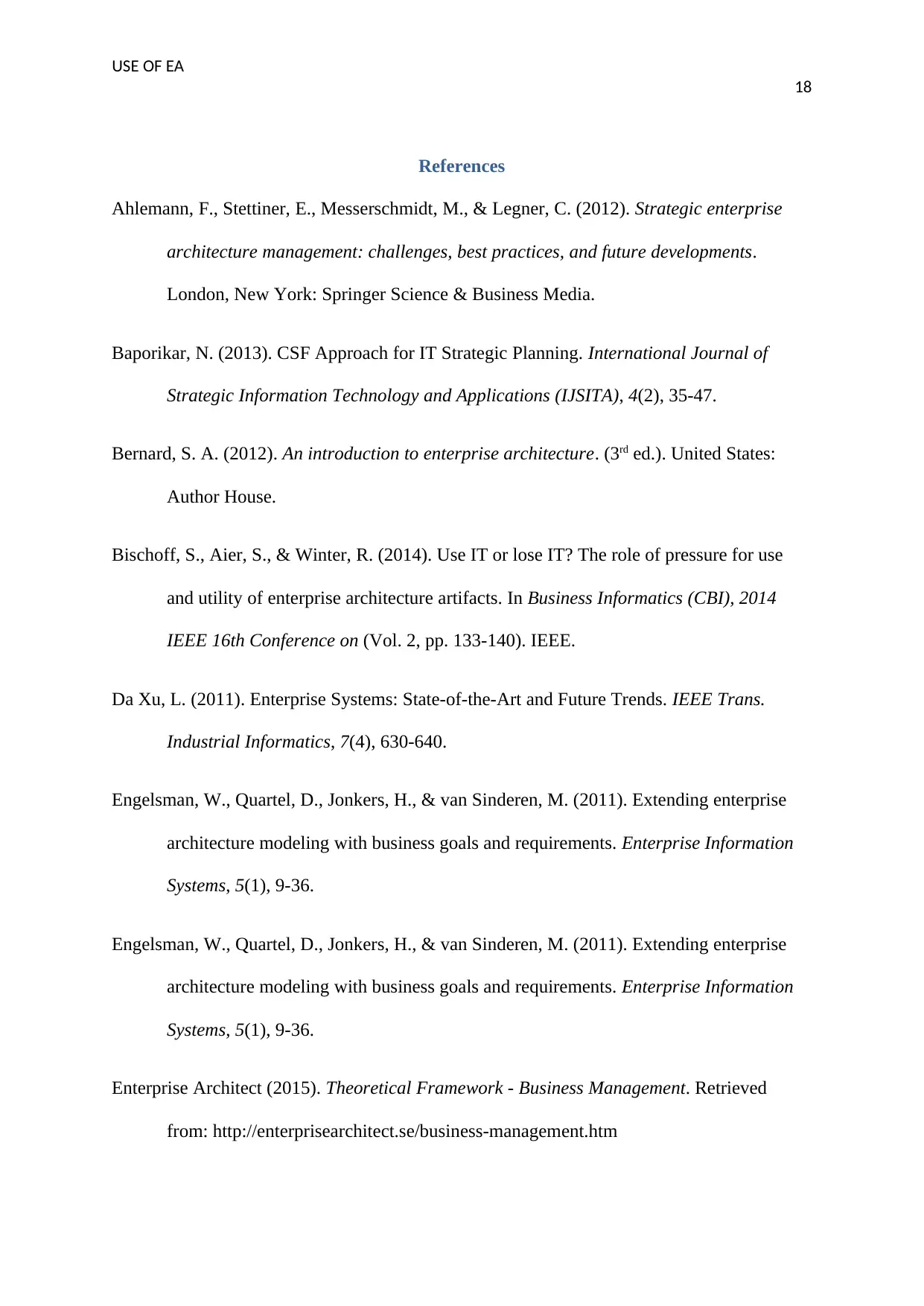
USE OF EA
18
References
Ahlemann, F., Stettiner, E., Messerschmidt, M., & Legner, C. (2012). Strategic enterprise
architecture management: challenges, best practices, and future developments.
London, New York: Springer Science & Business Media.
Baporikar, N. (2013). CSF Approach for IT Strategic Planning. International Journal of
Strategic Information Technology and Applications (IJSITA), 4(2), 35-47.
Bernard, S. A. (2012). An introduction to enterprise architecture. (3rd ed.). United States:
Author House.
Bischoff, S., Aier, S., & Winter, R. (2014). Use IT or lose IT? The role of pressure for use
and utility of enterprise architecture artifacts. In Business Informatics (CBI), 2014
IEEE 16th Conference on (Vol. 2, pp. 133-140). IEEE.
Da Xu, L. (2011). Enterprise Systems: State-of-the-Art and Future Trends. IEEE Trans.
Industrial Informatics, 7(4), 630-640.
Engelsman, W., Quartel, D., Jonkers, H., & van Sinderen, M. (2011). Extending enterprise
architecture modeling with business goals and requirements. Enterprise Information
Systems, 5(1), 9-36.
Engelsman, W., Quartel, D., Jonkers, H., & van Sinderen, M. (2011). Extending enterprise
architecture modeling with business goals and requirements. Enterprise Information
Systems, 5(1), 9-36.
Enterprise Architect (2015). Theoretical Framework - Business Management. Retrieved
from: http://enterprisearchitect.se/business-management.htm
18
References
Ahlemann, F., Stettiner, E., Messerschmidt, M., & Legner, C. (2012). Strategic enterprise
architecture management: challenges, best practices, and future developments.
London, New York: Springer Science & Business Media.
Baporikar, N. (2013). CSF Approach for IT Strategic Planning. International Journal of
Strategic Information Technology and Applications (IJSITA), 4(2), 35-47.
Bernard, S. A. (2012). An introduction to enterprise architecture. (3rd ed.). United States:
Author House.
Bischoff, S., Aier, S., & Winter, R. (2014). Use IT or lose IT? The role of pressure for use
and utility of enterprise architecture artifacts. In Business Informatics (CBI), 2014
IEEE 16th Conference on (Vol. 2, pp. 133-140). IEEE.
Da Xu, L. (2011). Enterprise Systems: State-of-the-Art and Future Trends. IEEE Trans.
Industrial Informatics, 7(4), 630-640.
Engelsman, W., Quartel, D., Jonkers, H., & van Sinderen, M. (2011). Extending enterprise
architecture modeling with business goals and requirements. Enterprise Information
Systems, 5(1), 9-36.
Engelsman, W., Quartel, D., Jonkers, H., & van Sinderen, M. (2011). Extending enterprise
architecture modeling with business goals and requirements. Enterprise Information
Systems, 5(1), 9-36.
Enterprise Architect (2015). Theoretical Framework - Business Management. Retrieved
from: http://enterprisearchitect.se/business-management.htm
Paraphrase This Document
Need a fresh take? Get an instant paraphrase of this document with our AI Paraphraser
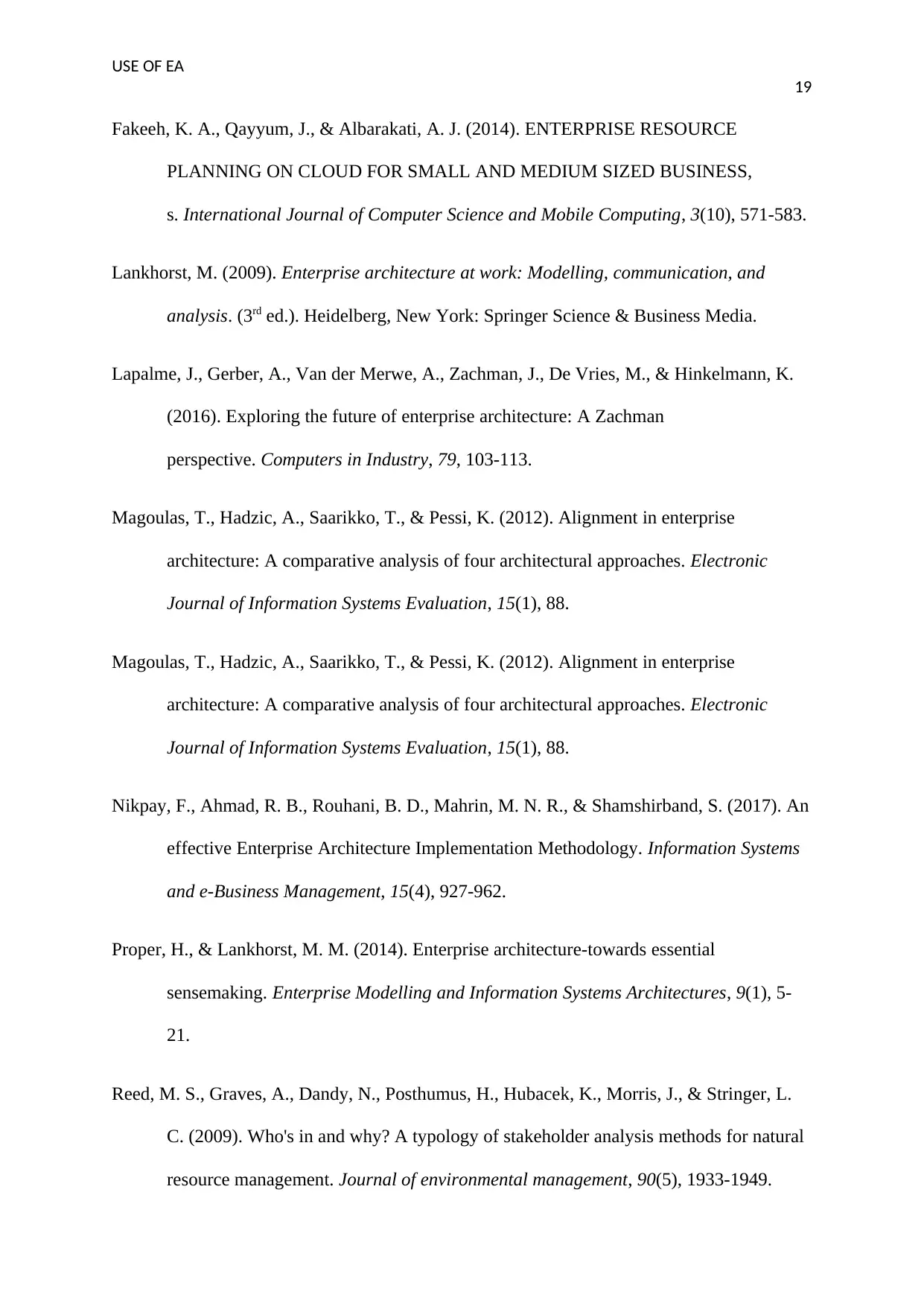
USE OF EA
19
Fakeeh, K. A., Qayyum, J., & Albarakati, A. J. (2014). ENTERPRISE RESOURCE
PLANNING ON CLOUD FOR SMALL AND MEDIUM SIZED BUSINESS,
s. International Journal of Computer Science and Mobile Computing, 3(10), 571-583.
Lankhorst, M. (2009). Enterprise architecture at work: Modelling, communication, and
analysis. (3rd ed.). Heidelberg, New York: Springer Science & Business Media.
Lapalme, J., Gerber, A., Van der Merwe, A., Zachman, J., De Vries, M., & Hinkelmann, K.
(2016). Exploring the future of enterprise architecture: A Zachman
perspective. Computers in Industry, 79, 103-113.
Magoulas, T., Hadzic, A., Saarikko, T., & Pessi, K. (2012). Alignment in enterprise
architecture: A comparative analysis of four architectural approaches. Electronic
Journal of Information Systems Evaluation, 15(1), 88.
Magoulas, T., Hadzic, A., Saarikko, T., & Pessi, K. (2012). Alignment in enterprise
architecture: A comparative analysis of four architectural approaches. Electronic
Journal of Information Systems Evaluation, 15(1), 88.
Nikpay, F., Ahmad, R. B., Rouhani, B. D., Mahrin, M. N. R., & Shamshirband, S. (2017). An
effective Enterprise Architecture Implementation Methodology. Information Systems
and e-Business Management, 15(4), 927-962.
Proper, H., & Lankhorst, M. M. (2014). Enterprise architecture-towards essential
sensemaking. Enterprise Modelling and Information Systems Architectures, 9(1), 5-
21.
Reed, M. S., Graves, A., Dandy, N., Posthumus, H., Hubacek, K., Morris, J., & Stringer, L.
C. (2009). Who's in and why? A typology of stakeholder analysis methods for natural
resource management. Journal of environmental management, 90(5), 1933-1949.
19
Fakeeh, K. A., Qayyum, J., & Albarakati, A. J. (2014). ENTERPRISE RESOURCE
PLANNING ON CLOUD FOR SMALL AND MEDIUM SIZED BUSINESS,
s. International Journal of Computer Science and Mobile Computing, 3(10), 571-583.
Lankhorst, M. (2009). Enterprise architecture at work: Modelling, communication, and
analysis. (3rd ed.). Heidelberg, New York: Springer Science & Business Media.
Lapalme, J., Gerber, A., Van der Merwe, A., Zachman, J., De Vries, M., & Hinkelmann, K.
(2016). Exploring the future of enterprise architecture: A Zachman
perspective. Computers in Industry, 79, 103-113.
Magoulas, T., Hadzic, A., Saarikko, T., & Pessi, K. (2012). Alignment in enterprise
architecture: A comparative analysis of four architectural approaches. Electronic
Journal of Information Systems Evaluation, 15(1), 88.
Magoulas, T., Hadzic, A., Saarikko, T., & Pessi, K. (2012). Alignment in enterprise
architecture: A comparative analysis of four architectural approaches. Electronic
Journal of Information Systems Evaluation, 15(1), 88.
Nikpay, F., Ahmad, R. B., Rouhani, B. D., Mahrin, M. N. R., & Shamshirband, S. (2017). An
effective Enterprise Architecture Implementation Methodology. Information Systems
and e-Business Management, 15(4), 927-962.
Proper, H., & Lankhorst, M. M. (2014). Enterprise architecture-towards essential
sensemaking. Enterprise Modelling and Information Systems Architectures, 9(1), 5-
21.
Reed, M. S., Graves, A., Dandy, N., Posthumus, H., Hubacek, K., Morris, J., & Stringer, L.
C. (2009). Who's in and why? A typology of stakeholder analysis methods for natural
resource management. Journal of environmental management, 90(5), 1933-1949.
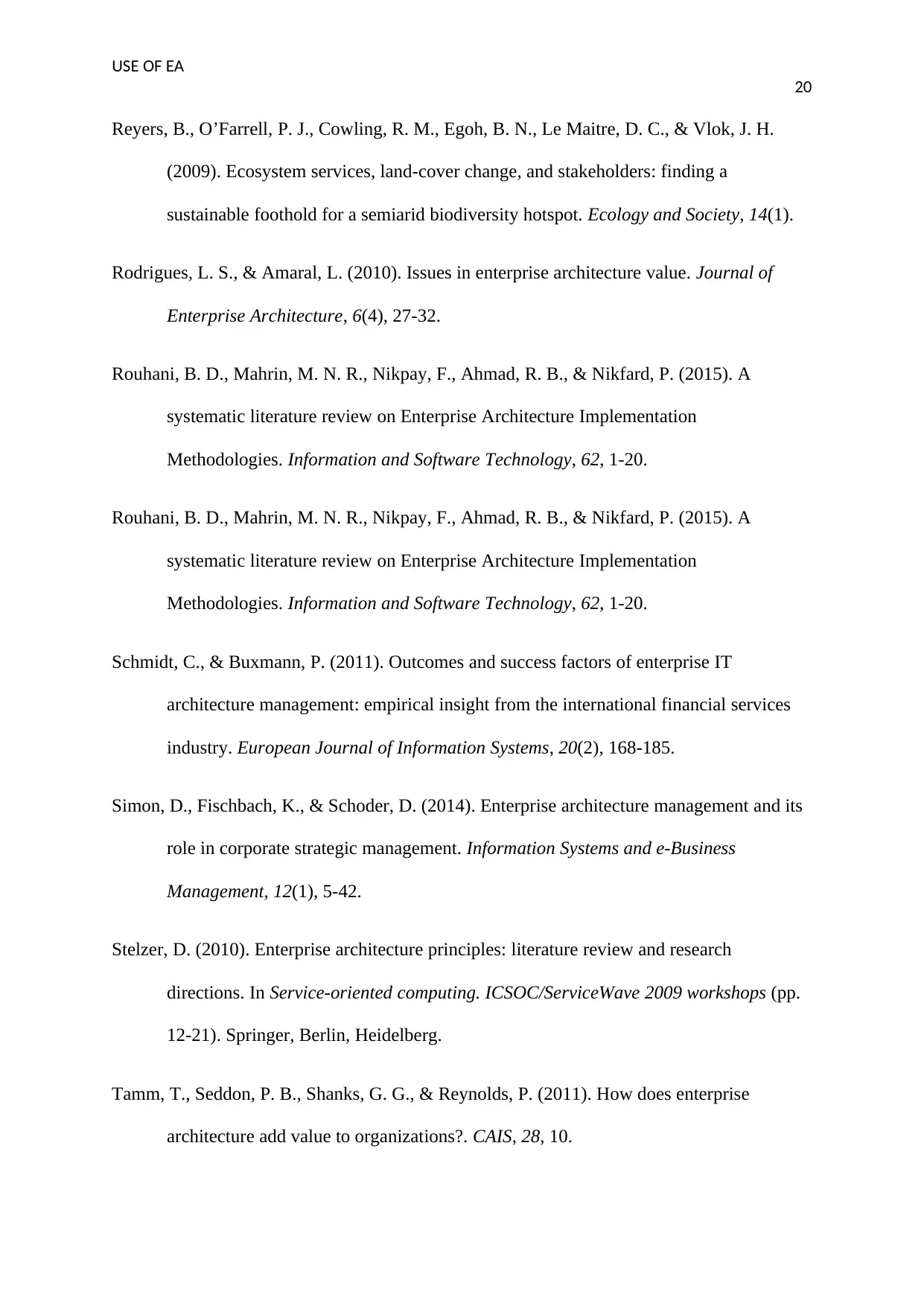
USE OF EA
20
Reyers, B., O’Farrell, P. J., Cowling, R. M., Egoh, B. N., Le Maitre, D. C., & Vlok, J. H.
(2009). Ecosystem services, land-cover change, and stakeholders: finding a
sustainable foothold for a semiarid biodiversity hotspot. Ecology and Society, 14(1).
Rodrigues, L. S., & Amaral, L. (2010). Issues in enterprise architecture value. Journal of
Enterprise Architecture, 6(4), 27-32.
Rouhani, B. D., Mahrin, M. N. R., Nikpay, F., Ahmad, R. B., & Nikfard, P. (2015). A
systematic literature review on Enterprise Architecture Implementation
Methodologies. Information and Software Technology, 62, 1-20.
Rouhani, B. D., Mahrin, M. N. R., Nikpay, F., Ahmad, R. B., & Nikfard, P. (2015). A
systematic literature review on Enterprise Architecture Implementation
Methodologies. Information and Software Technology, 62, 1-20.
Schmidt, C., & Buxmann, P. (2011). Outcomes and success factors of enterprise IT
architecture management: empirical insight from the international financial services
industry. European Journal of Information Systems, 20(2), 168-185.
Simon, D., Fischbach, K., & Schoder, D. (2014). Enterprise architecture management and its
role in corporate strategic management. Information Systems and e-Business
Management, 12(1), 5-42.
Stelzer, D. (2010). Enterprise architecture principles: literature review and research
directions. In Service-oriented computing. ICSOC/ServiceWave 2009 workshops (pp.
12-21). Springer, Berlin, Heidelberg.
Tamm, T., Seddon, P. B., Shanks, G. G., & Reynolds, P. (2011). How does enterprise
architecture add value to organizations?. CAIS, 28, 10.
20
Reyers, B., O’Farrell, P. J., Cowling, R. M., Egoh, B. N., Le Maitre, D. C., & Vlok, J. H.
(2009). Ecosystem services, land-cover change, and stakeholders: finding a
sustainable foothold for a semiarid biodiversity hotspot. Ecology and Society, 14(1).
Rodrigues, L. S., & Amaral, L. (2010). Issues in enterprise architecture value. Journal of
Enterprise Architecture, 6(4), 27-32.
Rouhani, B. D., Mahrin, M. N. R., Nikpay, F., Ahmad, R. B., & Nikfard, P. (2015). A
systematic literature review on Enterprise Architecture Implementation
Methodologies. Information and Software Technology, 62, 1-20.
Rouhani, B. D., Mahrin, M. N. R., Nikpay, F., Ahmad, R. B., & Nikfard, P. (2015). A
systematic literature review on Enterprise Architecture Implementation
Methodologies. Information and Software Technology, 62, 1-20.
Schmidt, C., & Buxmann, P. (2011). Outcomes and success factors of enterprise IT
architecture management: empirical insight from the international financial services
industry. European Journal of Information Systems, 20(2), 168-185.
Simon, D., Fischbach, K., & Schoder, D. (2014). Enterprise architecture management and its
role in corporate strategic management. Information Systems and e-Business
Management, 12(1), 5-42.
Stelzer, D. (2010). Enterprise architecture principles: literature review and research
directions. In Service-oriented computing. ICSOC/ServiceWave 2009 workshops (pp.
12-21). Springer, Berlin, Heidelberg.
Tamm, T., Seddon, P. B., Shanks, G. G., & Reynolds, P. (2011). How does enterprise
architecture add value to organizations?. CAIS, 28, 10.
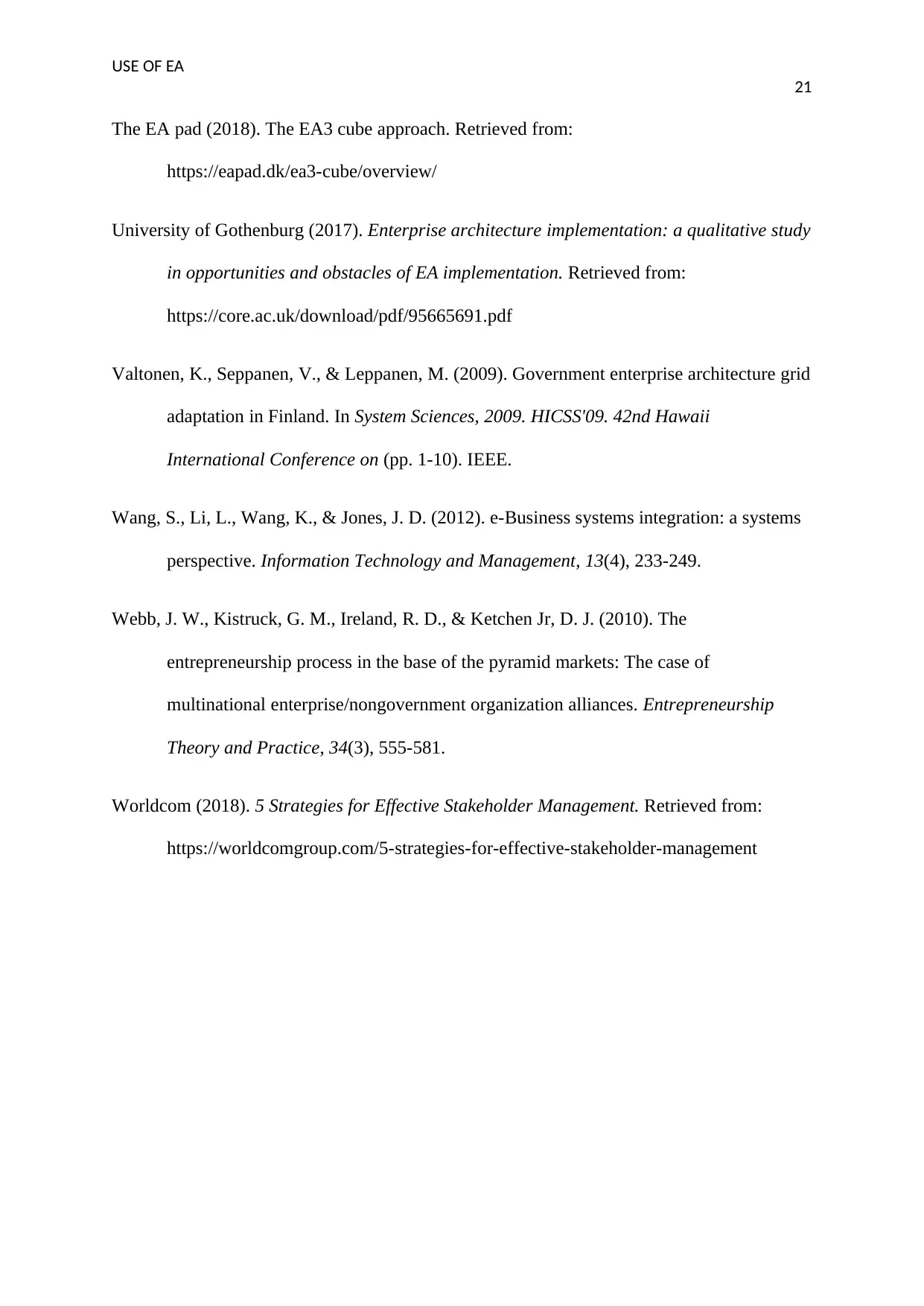
USE OF EA
21
The EA pad (2018). The EA3 cube approach. Retrieved from:
https://eapad.dk/ea3-cube/overview/
University of Gothenburg (2017). Enterprise architecture implementation: a qualitative study
in opportunities and obstacles of EA implementation. Retrieved from:
https://core.ac.uk/download/pdf/95665691.pdf
Valtonen, K., Seppanen, V., & Leppanen, M. (2009). Government enterprise architecture grid
adaptation in Finland. In System Sciences, 2009. HICSS'09. 42nd Hawaii
International Conference on (pp. 1-10). IEEE.
Wang, S., Li, L., Wang, K., & Jones, J. D. (2012). e-Business systems integration: a systems
perspective. Information Technology and Management, 13(4), 233-249.
Webb, J. W., Kistruck, G. M., Ireland, R. D., & Ketchen Jr, D. J. (2010). The
entrepreneurship process in the base of the pyramid markets: The case of
multinational enterprise/nongovernment organization alliances. Entrepreneurship
Theory and Practice, 34(3), 555-581.
Worldcom (2018). 5 Strategies for Effective Stakeholder Management. Retrieved from:
https://worldcomgroup.com/5-strategies-for-effective-stakeholder-management
21
The EA pad (2018). The EA3 cube approach. Retrieved from:
https://eapad.dk/ea3-cube/overview/
University of Gothenburg (2017). Enterprise architecture implementation: a qualitative study
in opportunities and obstacles of EA implementation. Retrieved from:
https://core.ac.uk/download/pdf/95665691.pdf
Valtonen, K., Seppanen, V., & Leppanen, M. (2009). Government enterprise architecture grid
adaptation in Finland. In System Sciences, 2009. HICSS'09. 42nd Hawaii
International Conference on (pp. 1-10). IEEE.
Wang, S., Li, L., Wang, K., & Jones, J. D. (2012). e-Business systems integration: a systems
perspective. Information Technology and Management, 13(4), 233-249.
Webb, J. W., Kistruck, G. M., Ireland, R. D., & Ketchen Jr, D. J. (2010). The
entrepreneurship process in the base of the pyramid markets: The case of
multinational enterprise/nongovernment organization alliances. Entrepreneurship
Theory and Practice, 34(3), 555-581.
Worldcom (2018). 5 Strategies for Effective Stakeholder Management. Retrieved from:
https://worldcomgroup.com/5-strategies-for-effective-stakeholder-management
1 out of 22
Related Documents
Your All-in-One AI-Powered Toolkit for Academic Success.
+13062052269
info@desklib.com
Available 24*7 on WhatsApp / Email
![[object Object]](/_next/static/media/star-bottom.7253800d.svg)
Unlock your academic potential
© 2024 | Zucol Services PVT LTD | All rights reserved.





